
James Reynolds, CA
(1926-2010)
James Reynolds played out the adventures of childhood away from the sprawl of the cities, in the shadow of California’s High Sierras. He fell under the spell of the mountains, of uncrowded country, and reveled in stories of wild times and bonanza gold. His initial interest in art centered upon a Frank Tenney Johnson calendar reproduction he saw at the age of 13.
Following service in the South Pacific during World War II, Reynolds studied at the School of Allied Arts in Los Angeles. He then pursued a brief career in commercial art and soon went on to Hollywood to the motion-picture studios where he would remain for the next 15 years. In the tradition of the great illustrators before him, Reynolds kept a part of himself separate from the routine of his professional work. On his own time he remembered Frank Tenney Johnson and dreamed of unspoiled places against the mountains far from the clatter and clutter of the city. And he painted those places, at first for himself, and then for others who recognized his talent and shared his love of the land.
In 1967 Reynolds gave up a solid career in the film industry and chose instead the uncertainty of a fine-art future on a piece of raw land outside Sedona, Arizona. His art came alive there with the colors of sunup and sundown among the rugged red rocks and beneath the royal blue midday skies. There was an eager audience for his work through the galleries in Scottsdale, and the acceptance of his peers came with membership in the Cowboy Artists of America in 1968.
James Reynolds continued to paint from his heart and his love of landscapes remained a dominant force in his art. It was forever the places – wide open, wild and unscarred – that retained a fierce hold on James Reynolds’ sensibilities and inspired his accomplished approach to painting.
Source: Claggett/Rey Gallery

Taos Chief
Artist: James Reynolds, CA (1926-2010)
Description: Oil | Image Size: 12h x 9”w; Framed Size: 20 ½”h x 17”wpainting
Better known for his landscapes, modern ranching scenes, and historical narratives, James Reynolds also excels at portraiture as this small painting attests. Bold and vibrant brush strokes are used to effectively capture the personality and essence of the subject. His face is seen at a slight profile with the light source to his left. Age lines around the chief’s eyes add a touch of authenticity and realism to this impressionistic portrait.
On the Edge
Artist: James Reynolds, CA (1926-2010)
Description: Oil (1991) | Image Size: 24”h x 36”w; Framed Size: 34”h x 46”wpainting
“On the Edge” combines two of James Reynolds’ favorite subjects, the cowboy and the Arizona landscape. The cowboy riding along the edge of a vast canyon is lit by the same sunlight that washes across the landscape. The pink light reflected in his clothing is the same color that is reflected by the canyon walls in the far distance which brings a sense of continuity to the entire painting. The cowboy and his horse are riding toward the sun and are shown in high relief, as is the ground around them. The details of the cowboy’s clothing and gear are easily seen and the ground beneath them is equally detailed. As the viewer’s eye continues to take in the rest of the scene, hard details become less distinct in the same fashion that one would notice were he standing on the rim of a canyon gazing across a vast chasm. Reynolds is certainly skilled as a figure painter, but this painting reminds us that he may well have been an even better landscape painter.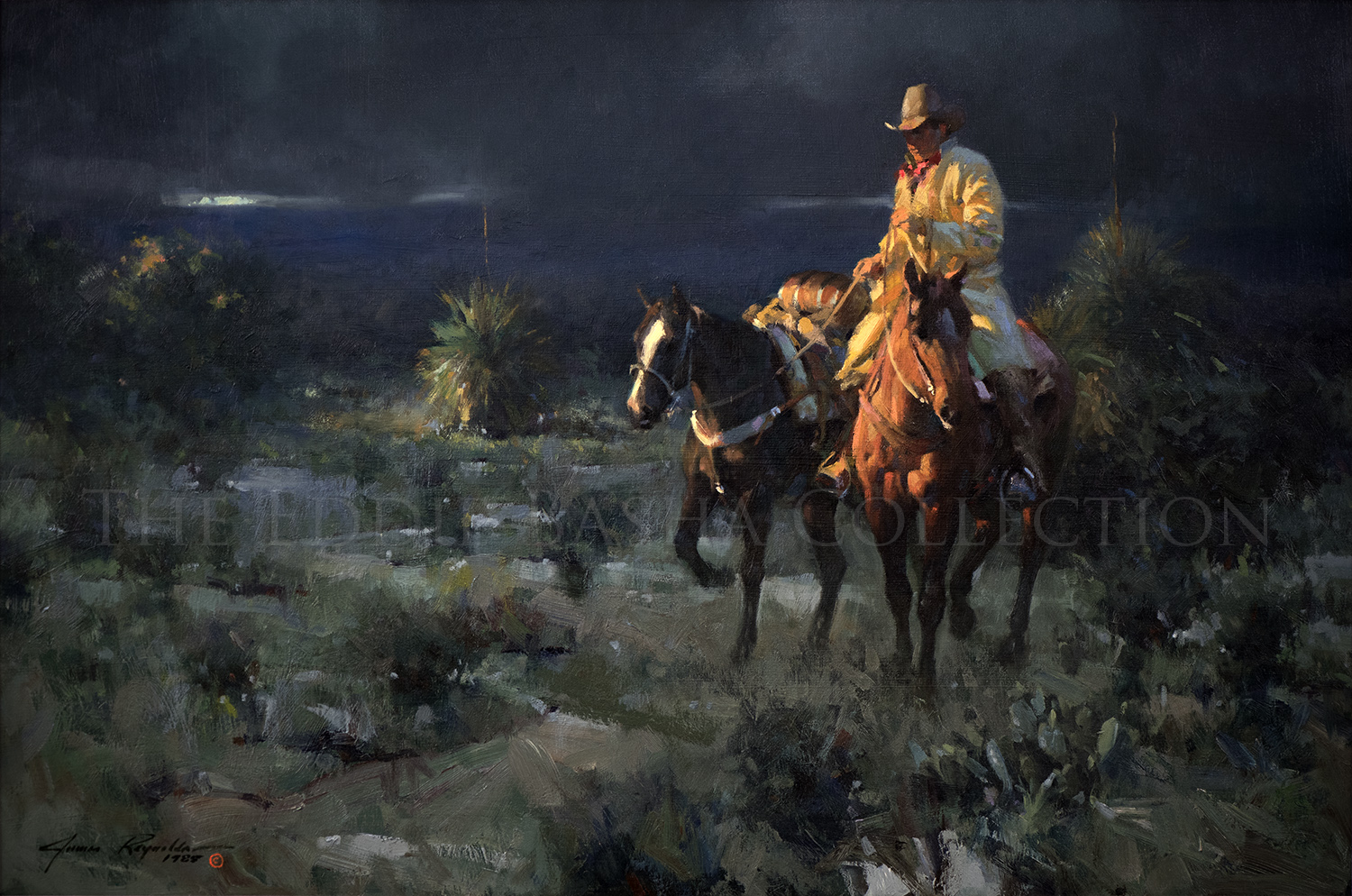
Sabino Canyon
Artist: James Reynolds, CA (1926-2010)
Description: Oil (1985) | Image Size: 24”h x 36”w; Framed Size: 34 5/8”h x 46 3/8”wpainting
This relatively large James Reynolds oil captures the urgency of a cowboy putting distance between himself and his mounts and a threatening thunderstorm in the background. The cowboy has just ridden into a patch of light, probably the last rays of sunshine he will feel before the storm hits. “Sabino Canyon” was loaned to the Thomas Gilcrease Institute of American History & Art in Tulsa (OK) April-July 1993, for the Rendezvous 1993 Exhibition.
“Sabino Canyon is located within the Santa Catalina Mountains in the Coronado National Forest and is a part of the Sonoran Desert. The canyon is just outside the Tucson AZ city limits.
The Santa Catalina Mountains began forming 12 million years ago. The movement of the mountains created the mountain peaks as well as the basin, or bowl-shaped land, on which the city of Tucson is built. This movement of the mountain range stopped about 5 million years ago. The land formation is called Basin and Range. Approximately 8,000 years ago the first saguaros began growing in the canyon and about 4,000 years ago the first paloverde trees took root in the canyon. There is evidence in pieces of pottery, or shards, and pit house foundations that the Hohokam people lived in the canyon between 300 and about 1400 AD. With the Gadsden Purchase in 1854, Sabino Canyon became part of the United States.
The area is managed by the Forest Service. Their jobs include maintaining the canyon as a recreation area and learning center, protecting the creek, soil, and wildlife, and managing the relationship between Tucson and the canyon, including controlling fires and floods. Sabino Canyon is a treasure for Tucson residents and tourists alike.” Resource: https://sabinocanyon4kids.com/history.html . Visitor information can be found at https://www.fs.usda.gov/coronado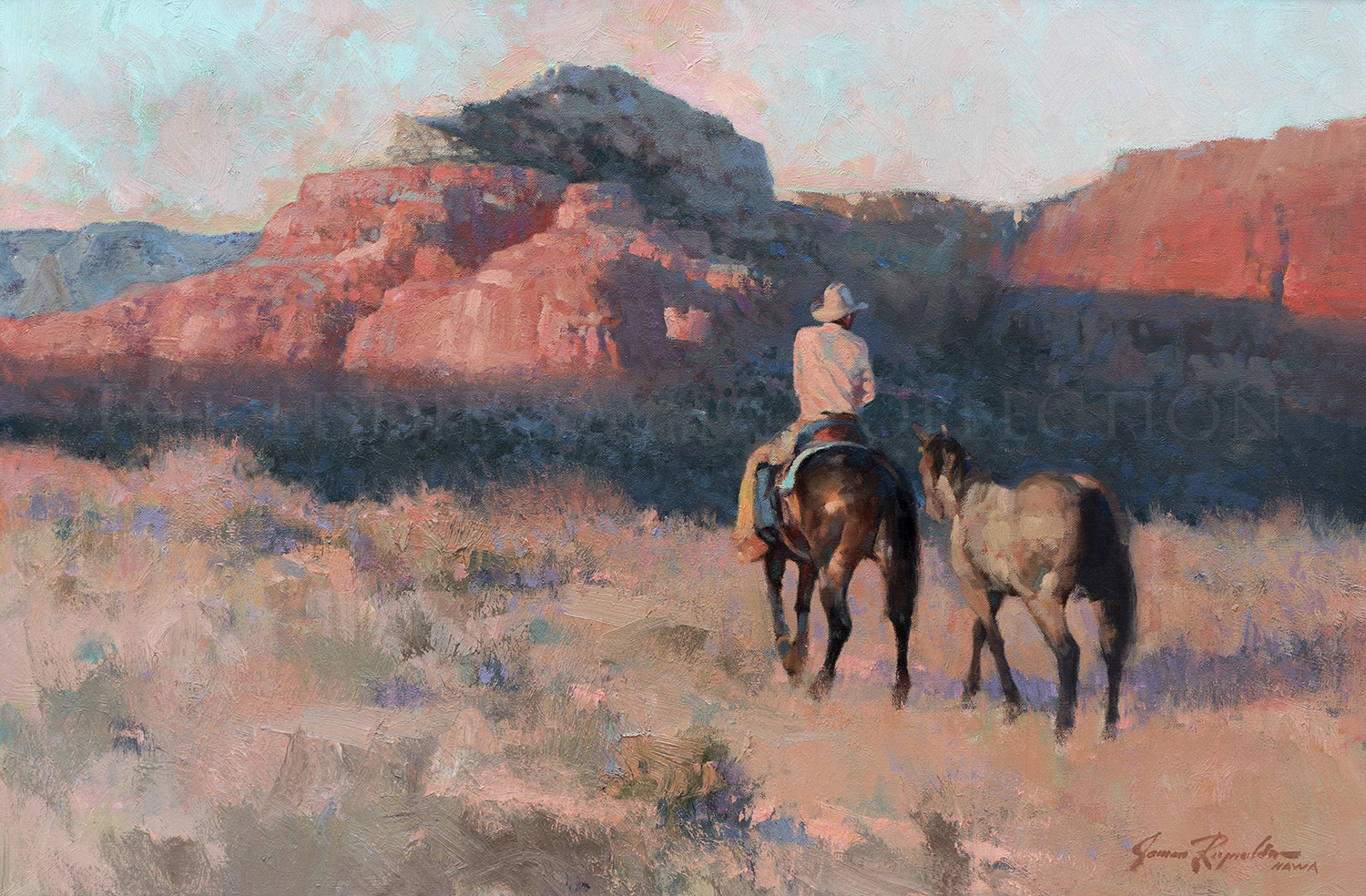
Rim Country
Artist: James Reynolds, CA (1926-2010)
Description: Oil (1991) | Image Size: 20”h x 30”w; Framed Size: 30 ½”h x 40”wpainting
In this oil painting of a mounted cowboy leading another horse away from the viewer, James
Reynolds shows his skill as an impressionistic landscape painter. The painting is as much about shadings of light, color, tone, and texture as it is about the figures of horses and rider. By turning the figures’ backs to the viewer, Reynolds emphasizes that he has concentrated on creating a painting that is evocative of a certain time of day and location. It is the transition between sunlight and shadow, from the muted tones of the foreground to the dark band of shadowed ground in front of the rider, and finally to the red rocks and pale blue sky of the background, that has most captured the artist’s imagination. His intent, which he has masterfully succeeded at, is to create a mood that conveys his feeling for the land and the beauty of nature. As in many of his paintings, color and light are the stars of this canvas.
In case you were wondering, in Arizona “rim country” typically refers to the Mogollon which cuts across the northern half of Arizona extending approximately 200 miles beginning in Yavapai County and extended eastward toward the New Mexico border forming the southern edge of the Colorado Plateau.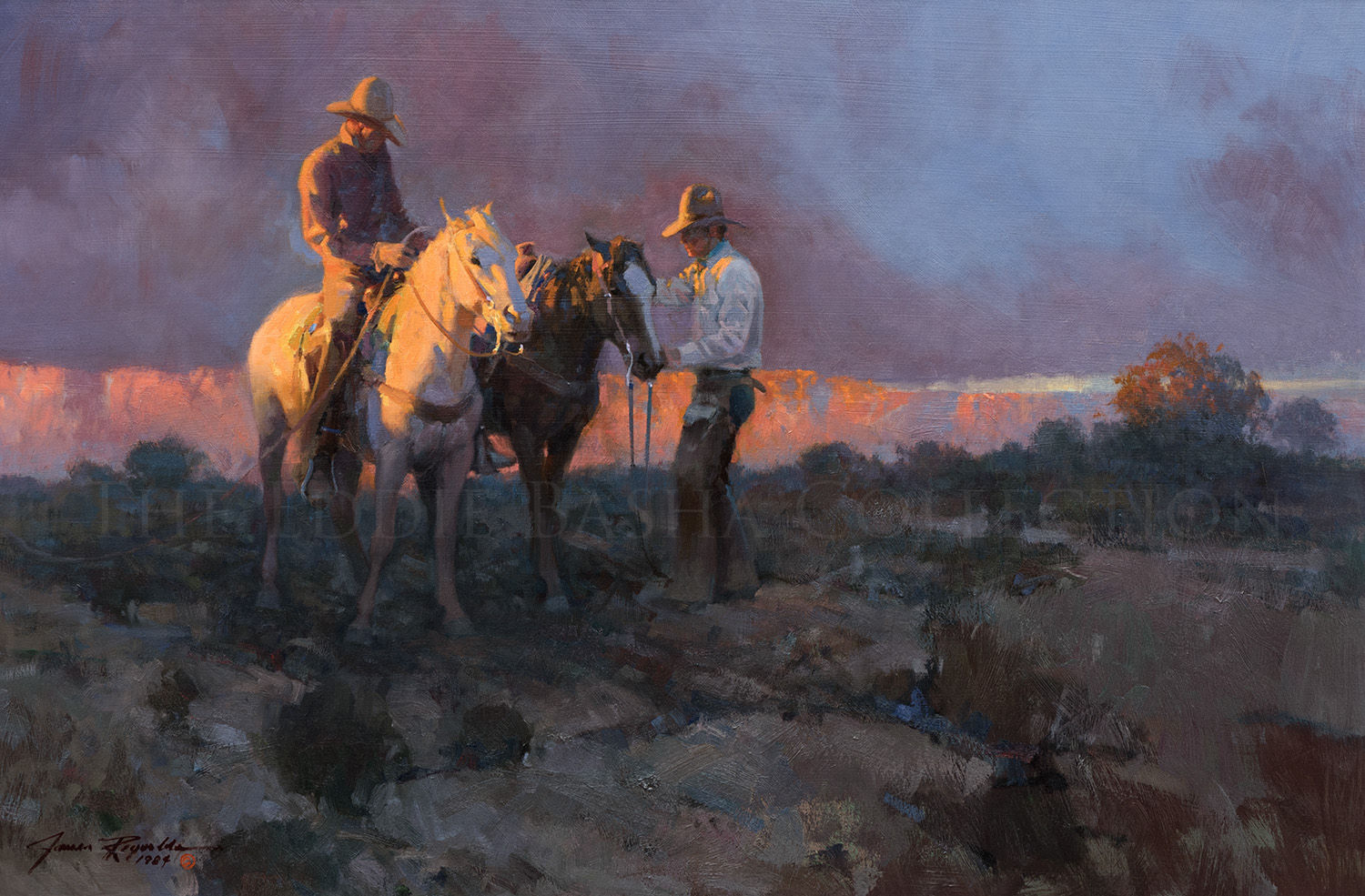
On the Mogollon
Artist: James Reynolds, CA (1926-2010)
Description: Oil | Image Size: 24”h x 36”w; Framed Size: 34 ½:h x 46 ½”wpainting
“On the Mogollon” by CAA artist James Reynolds is a relatively simple scene in terms of its subject: two cowboys pause in their travels while one of them dismounts to adjust his horse’s bridle. One cowboy remains mounted and watches his friend’s progress. However, the subject of the painting is the only element that is simple. The surrounding landscape is spectacular; the cowboys are traveling along the rim of a deep canyon with an immense desert falling away into the background. The use of sunlight in the painting dramatically enhances every facet of the scene; shimmering off the white horse and white shirt of the dismounted rider while illuminating and bathing the canyon in a pink, orange, and purple glow. Reynolds’ impressionistic technique of soft edges, subtle blending of colors, and above all his masterful handling of light perfectly evokes a fleeting moment frozen in time.
The Mogollon Rim in Northern Arizona stretches 200 miles from Yavapai County to New Mexico and provides spectacular views overlooking an expansive forest of pine trees. The rim is a true geological wonder. The inhabitants of Arizona, past and present, as well as a plethora of visitors have enjoyed “Rim” country’s many splendors … hunting, fishing, horseback riding, stargazing, rock climbing, bird watching, hiking, bike riding, and picnicking.
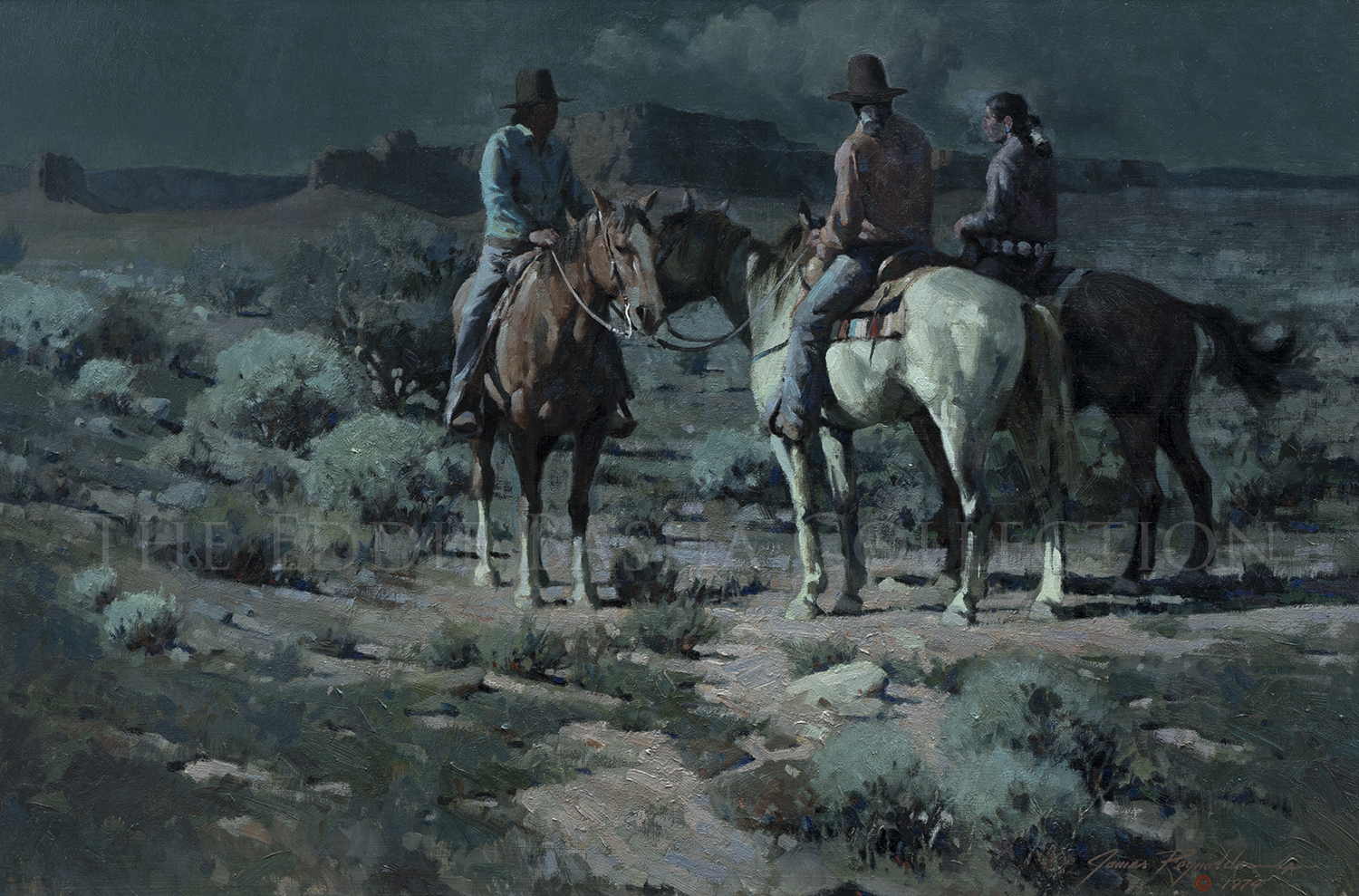
Navajos
Artist: James Reynolds, CA (1926-2010)
Description: Oil (1974) | Image Size: 24”h x 36”w; Framed Size: 33”h x 45”wpainting
In this painting, James Reynolds once again demonstrates his skill with nocturnals. His blending of colors and shades, his depiction of varying textures, and his handling of a glancing moonlight as his chief source of light combine to produce a highly effective scene that captures the spirit of the moment. Three Navajo riders have paused on their journey; two appear to be traveling together while a third rider seems to have met them on the trail. They are shown in the glow of the moonlight, which is primarily reflected off of the white horse in the center of the painting, while the rest of the canvas is painted in dark and muted tones. The action of the painting is very quiet, as is befitting of the moment being depicted. We do not know why these riders have stopped, nor do we know if they are engaging in a conversation—-that part of the painting remains a mystery, but we do feel the quietness and serenity of the night.
“Navajos” made its debut at the 9th Annual Cowboy Artists of America Exhibition at the Phoenix Art Museum in 1974. And, in 2017, it was exhibited at the “By the Light of the Moon” exhibition held at the Phippen Museum in Prescott. It remains a permanent part of The EBC Collection.
Travelin’ Alone
Artist: James Reynolds, CA (1926-2010)
Description: Oil (1994) | Image Size: 26”h x 36”w; Framed Size: 36”h x 45 ½”wpainting
James Reynolds often said that he simply liked to paint cowboys; he found them symbolic of a way of life that he admired. He often placed his cowboys against the backdrop of the Arizona landscape he loved, and also often focused on solitary figures such as this cowboy riding through the sagebrush leading his packhorse. Presented with the cowboy mid-journey, a distant butte in the background gives the viewer the sense that a long distance has just been covered with the implication that an equally long distance is still to be traversed. The scene is timeless; it could have been depicted yesterday, the last century, or perhaps what unfurls tomorrow. The cowboy rides at a steady and unhurried pace, covering a ground that is desolate yet beautiful. A self-sufficient figure in an endless landscape; an eloquent summation of Reynold’s feeling about the land and a lifestyle.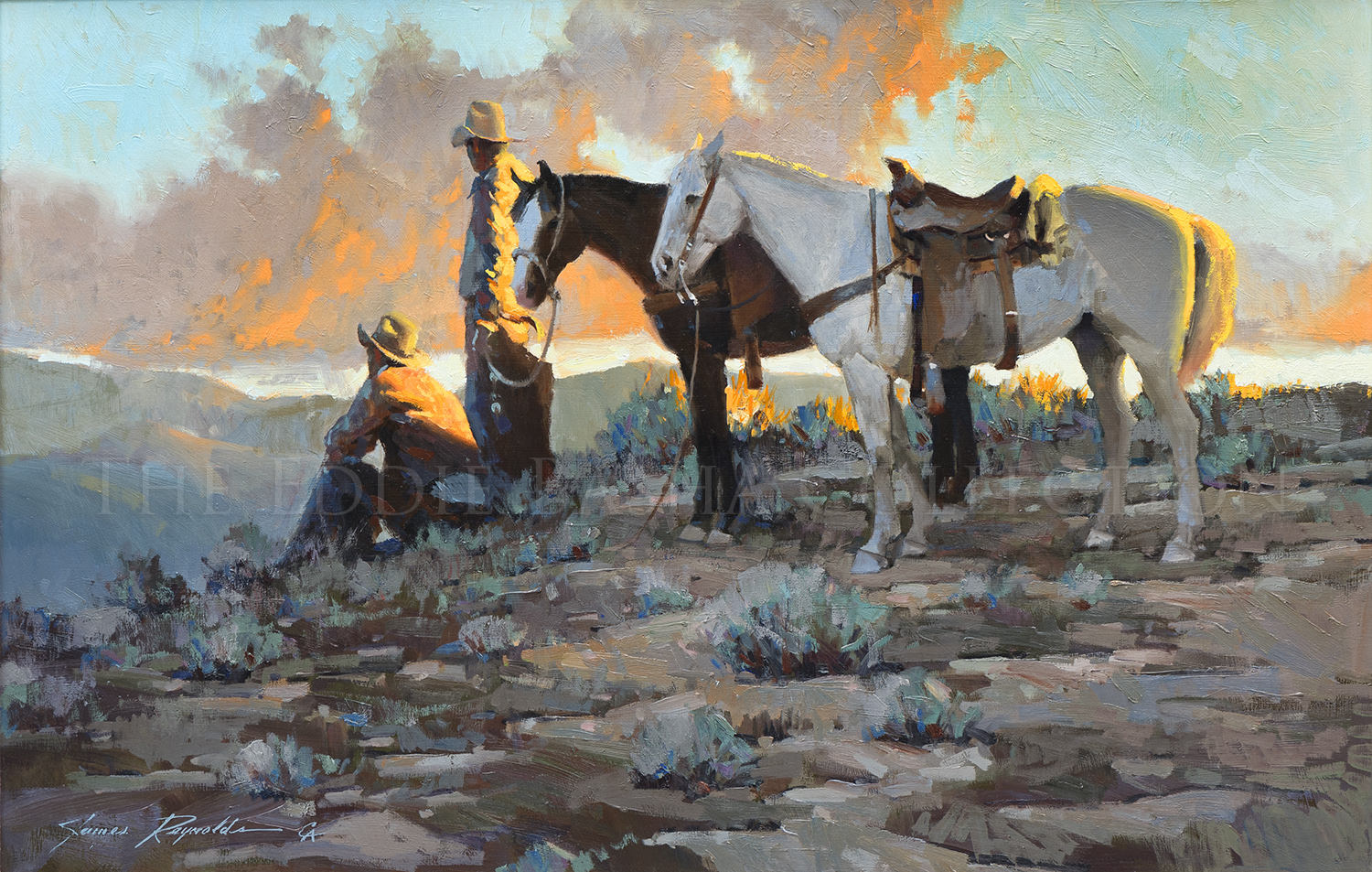
Day’s End
Artist: James Reynolds, CA (1926-2010)
Description: Oil | Image Size: 22”h x 34”w; Framed Size: 29”h x 41”wpainting
Dramatic lighting creates an evocative and contemplative mood in this oil painting of two cowboys taking a break after a long day in the saddle. The two have dismounted and gaze across a canyon taking in the brilliantly colored rays of the setting sun at day’s end. The majority of this piece is shown in the approach of dusk’s darkness, but James Reynolds has masterfully lit both men as well as some overhead clouds with the fading sunlight, now grown pink and orange. While this duo has obviously put in a full day’s work, they are still able to enjoy the peace and serenity accorded them by a beautiful scenic vista. And though much of western art portrays the action, drama, and perils of ranching, this piece offers a counterpoint to those subjects. Here, nature is the primary subject and the appreciation of her beauty is the story that Reynolds encapsulated. His talent as a colorist, his sensitivity toward nature’s grandeur, as well as his ability to create a mood are readily conveyed to observers prompting them to gaze across the wide expanse of a panoramic landscape under an extraordinary sky with the two cowboys.
Eddie Basha acquired this piece from the estate of the late Senator Barry Goldwater. The two shared a deep love and passion for Arizona, its people and art. Shortly before the Senator’s passing, the pair enjoyed a final visit with one another as they toured the gallery. They spoke of their mutual affinities as well as their memories of attending the annual Cowboy Artists of America Annual Show & Sale. At one point, Senator Goldwater asked Eddie “Can a guy just come and look at all this art anytime?” With quiet tears streaming down, Eddie responded, “Yes, Senator, anytime you want.” And a similar bittersweet moment was had just a few days prior to Eddie’s passing (March 26, 2013) when he last viewed the collection. It was as if he was seeing it for the very first time and he was genuinely overwhelmed by the extraordinary talents of the artists’ masterworks assembled. The emotionally-filled moment was evident as the quiet tears streamed once again.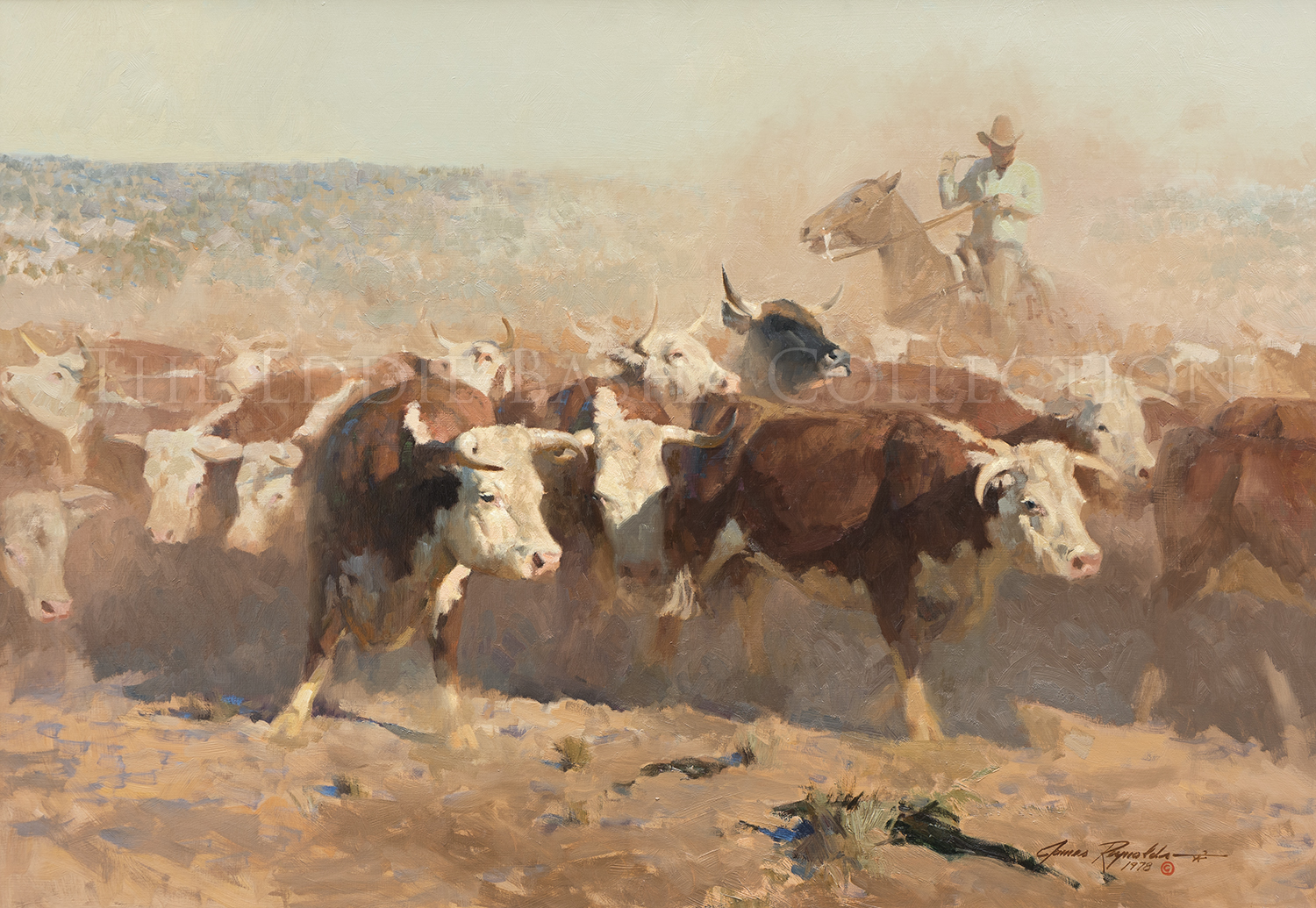
Gate Shy
Artist: James Reynolds, CA (1926-2010)
Description: Oil (1978) | Image Size: 28”h x 40”w; Framed Size: 38 ½” h x 50 ½” wpainting
Free-ranging cattle are never easy to pen during the seasonal round up. Handling cattle from horseback is the true source of cowboy pride, and it is the work which will always define who the cowboy really is. And because it is hard and dangerous work, a cowboy must be alert, agile, in complete command of his horse, and aware of his surroundings. In this painting of a cowboy working a herd of cattle on an open range, James Reynolds puts us in the midst of the action. The wrangler is turning the herd directly toward the viewer giving the effect of being just a step ahead of the cows as they move forward in billowing clouds of dust. The sunlight of the day is obscured by the dust in the background, but the white faces of the cattle are shown in sharp contrast to the background colors and features which blend together. By placing the cowboy in the right background moving toward the left and showing the cattle moving forward and to the right, Reynolds creates a circle of action and movement. He keeps our eyes focused on that movement by placing the cows with the whitest and brightest faces in the center of the circle.
“Gate Shy” made its first appearance at the 13th Annual Cowboy Artists of America Show & Sale in 1978. Reynolds also won the Colt Award that year selected by his fellow CAA artists in recognition of his body of work.
Horse Study
Artist: James Reynolds, CA (1926-2010)
Description: Oil | Image Size: 10”h x 14”w; Framed Size: 17”h x 21”w
James Reynolds was a versatile artist who excelled at all aspects of his craft. He was equally adept with landscapes, figure studies, still life images, and action scenes. Even in a small study such as this one of a standing horse, those skills are on full display. The anatomy of the horse is perfect, the contrasting use of lights and darks, shadows and sunlight, highlight the contours of the animal. The background both complements the horse, but also serves as a color contrast to heighten the viewer’s focus on the horse. It is a realistic study, but one that fully reflects the individual style and skill of the artist.
Morning Prayer
Artist: James Reynolds, CA (1926-2010)
Description: Oil Painting | Image Size: 18”h x 24”w; Framed Size: 26 ¼”h X 32 ¼”wpainting
Here a lone Plains Indian facing east with the morning sun reflecting off his buckskins and the coat of his white horse, he is offering a prayer on behalf of his entire tribe to start the day. He is holding what appears to be a bird fetish and eagle feather and is wearing a buffalo horn headdress suggesting he is a medicine man. Reynolds presents a simple scene with a quiet tone, but one that succinctly reflects the traditions of the Plains culture.
The Supply Wagon
Artist: James Reynolds, CA (1926-2010)
Description: Oil (1973) | Image Size: 28”h x 40”w; Framed Size: 38 ½”h x 50 3/8”wpainting
Reynolds uses a muted palette with shades of browns, yellows, and golds to depict a parched landscape that emphasizes the precarious nature of ranch and cattle work. He pictures three cowboys, two in a wagon, and one on horseback who are headed to a cow outfit with much needed supplies. The scene has a universal quality and could easily be set in the 1890’s or the 1980’s. For Reynolds, this slice of ranch life is a glimpse into both the past and present.
Following its 1973 debut at the 8th Annual CAA Exhibition & Sale held at the Phoenix Art Museum, “Supply Wagon” was later exhibited at the “Rendezvous 1993 Exhibition” at The Gilcrease Museum in Tulsa, Oklahoma and today remains a permanent part of The Eddie Basha Collection.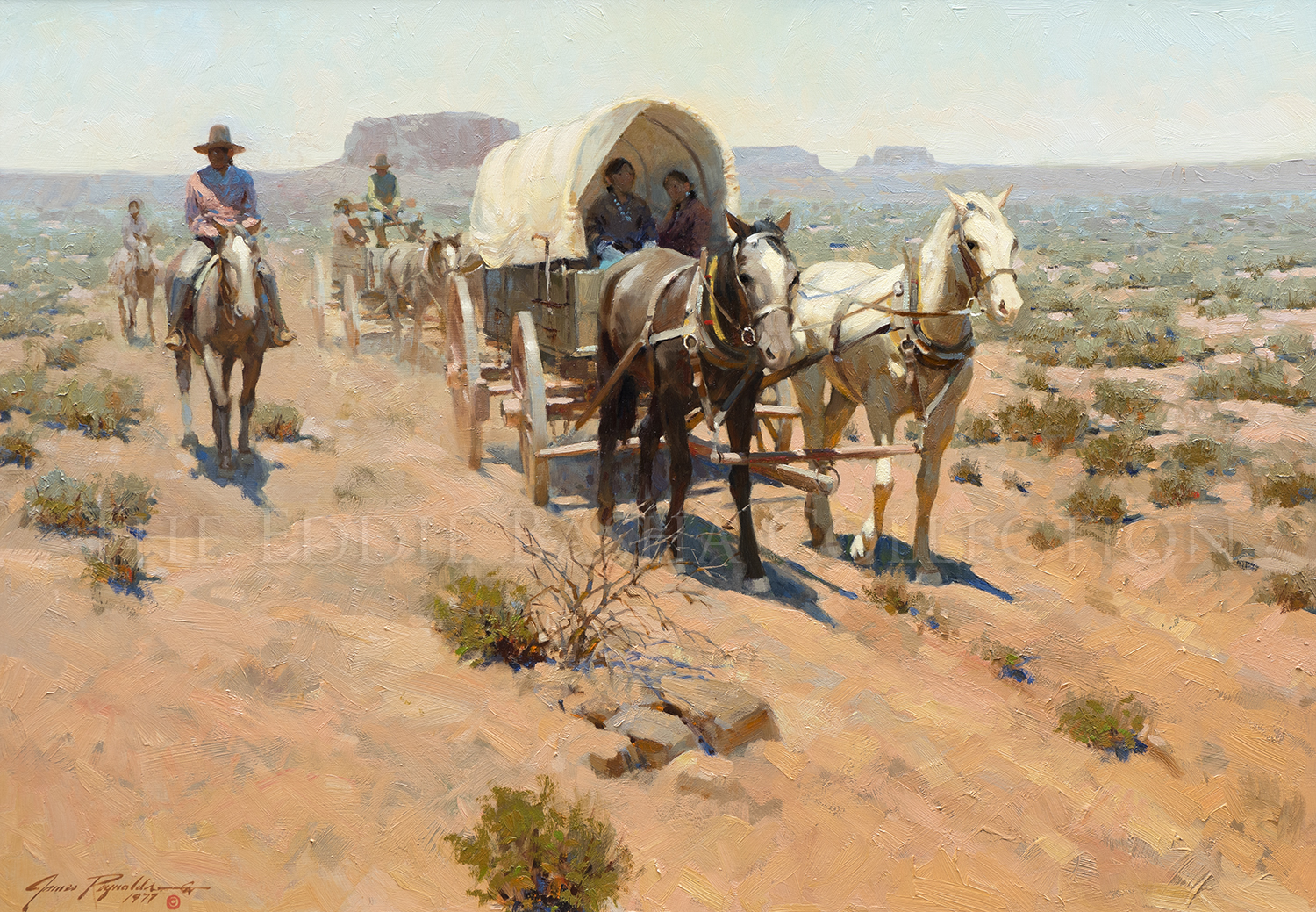
The Long Way Home
Artist: James Reynolds, CA (1926-2010)
Description: Oil (1977) | Image Size: 28”h x 40”w; Framed Size: 39”h x 50”wpainting
In “The Long Way Home” James Reynolds uses his composition to give the illusion of a vast open space. By placing the largest element in the painting, a horse drawn wagon, in the upper foreground and then arranging various figures in descending sizes behind the wagon, he pulls the viewer’s eye to the distant mesas on the far horizon. The effect gives a sense of just how much territory the wagon and riders have crossed. By using myriad colors to depict the landscape, he also effectively gives a feel for the desert locations.
A master colorist and born storyteller, Reynolds is often cited by other artists as someone who consistently combines all the elements of composition, color, and atmosphere into truly masterful paintings. Reynolds is adept at painting cowboys working a herd of cattle as he is at capturing the beauty of an Arizona sunset. One of his fellow artists has said, “Any painter who wants to learn how to really nail a picture of the west, whether it is the Old West or a scene right out of yesterday, would do well to take a hard look at James Reynold’s work. He gets all of the ingredients right and he does it with a style that is his alone.”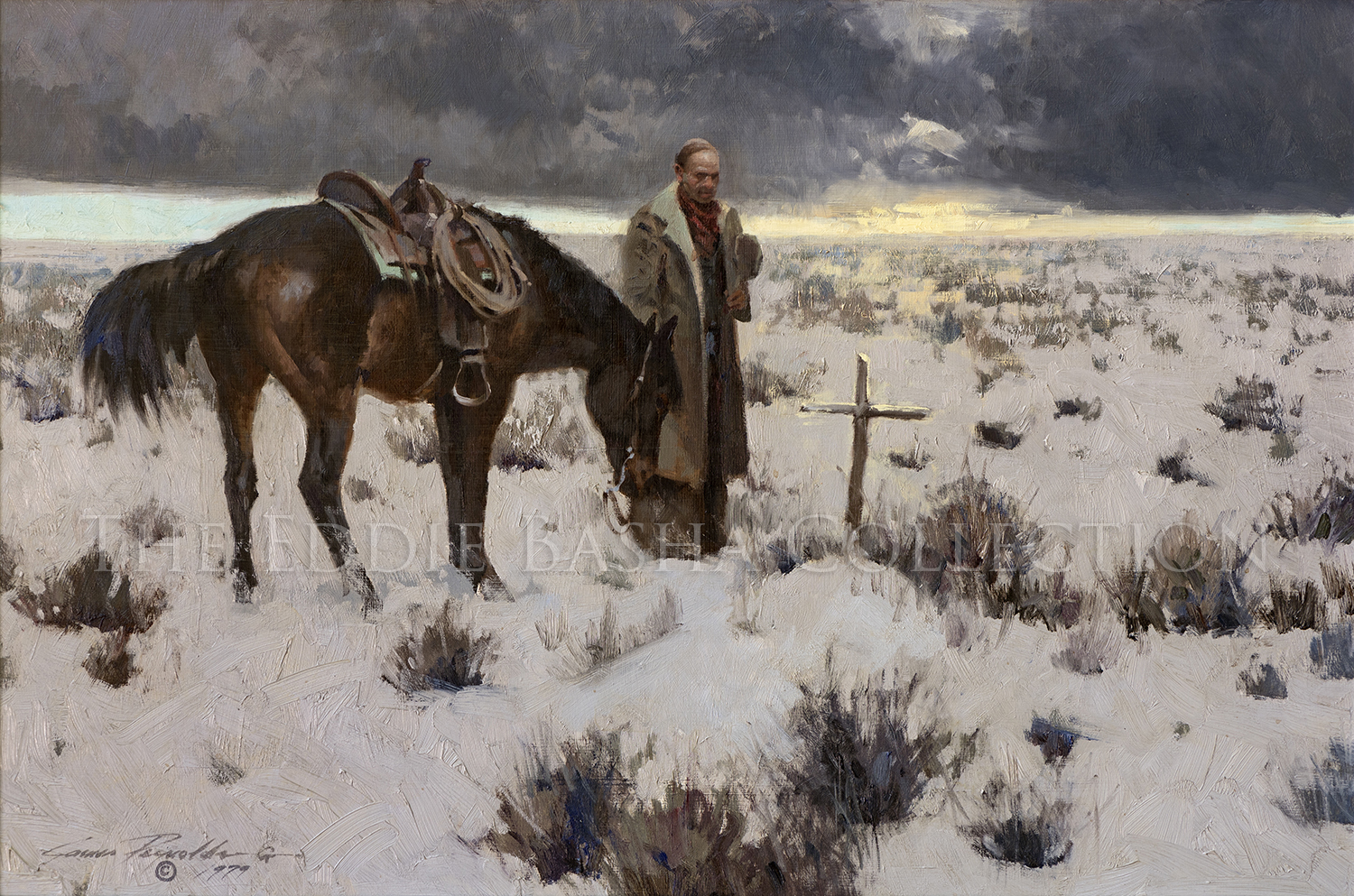
An Old Friend
Artist: James Reynolds, CA (1926-2010)
Description: Oil | Image Size: 20”h x 30”w; Framed Size: 29 ¼”h x 39 ¼”wpainting
Reynolds achieves a somber, yet sympathetic mood in this painting of a cowhand visiting the grave of a fallen friend by placing the horse and the dismounted rider in a snowy field with only a solitary cross marking the friend’s grave. The horses head is bowed and the cowhand’s hat has been removed which further adds to the tone. Dense gray clouds roiling overhead just above the setting sun keep the whole scene anchored.
The Last Gate
Artist: James Reynolds, CA (1926-2010)
Description: Oil (1974) | Image Size: 30”h x 48”w; Framed Size: 40 ½”h x 58 ½”wpainting
This large painting of a long trail of cattle being led by a small group of cowboys across the frozen, snow- covered ground truly evokes the bitter cold and harsh reality of working cattle in winter. It is a splendid example of Reynolds’ ability to create a specific mood and to depict a particular seasonal landscape. The painting is masterfully composed: As the viewer’s eye is guided from the upper right of the canvas where the line of cattle begins, the moving herd forms a semi-circle ending front and center with the depiction of the lead cowboy and three cows, one of which is a calf, giving an illusion of great space and the steady pace of the men and herd. And even though Reynolds uses impressionistic techniques in terms of brushstrokes and detail, the snowy landscape, the wisps of white clouds obscuring the background, and the cowboys in their winter garb paint a realistic setting for the action at hand. His purpose is not to present a photo realistic depiction of working a herd during the winter, but to evoke the feeling of that work and what that life would be like. Even the small details such as the cigarette dangling from the lead cowboy’s mouth adds to the authenticity of the scene.
“The Last Gate” won the Silver Medal in oil painting and the auspicious George Phippen Award, the most popular work in the show, at the 9th Annual Cowboy Artists of America Show & Sale in 1974 at the Phoenix Art Museum.
A Long Day Ahead
Artist: James Reynolds, CA (1926-2010)
Description: Oil (1985) | Image Size: 24”h x 36”w; Framed Size: 34 ½”h x 46 ½”wpainting
James Reynolds was adept at adding seemingly small details or effects that could greatly enhance the overall success of a painting. Here as a wrangler is working a small herd of cattle, a reddish brown cloud of dust is just beginning to obscure the figures of the cowboy and cows; the cowboy and cows are moving away from the viewer except for one small calf with a bright white face that has turned in the opposite direction. By painting that calf’s face in bright sunlight unobscured by the rising dust cloud, Reynolds focuses our attention on the center of the painting and the center of the action. The artist captured all of the various elements of this scene from the milling action of the cows, the impressionistic handling of the landscape, and the masterful use of color and light to emphasize the inherent drama of the action.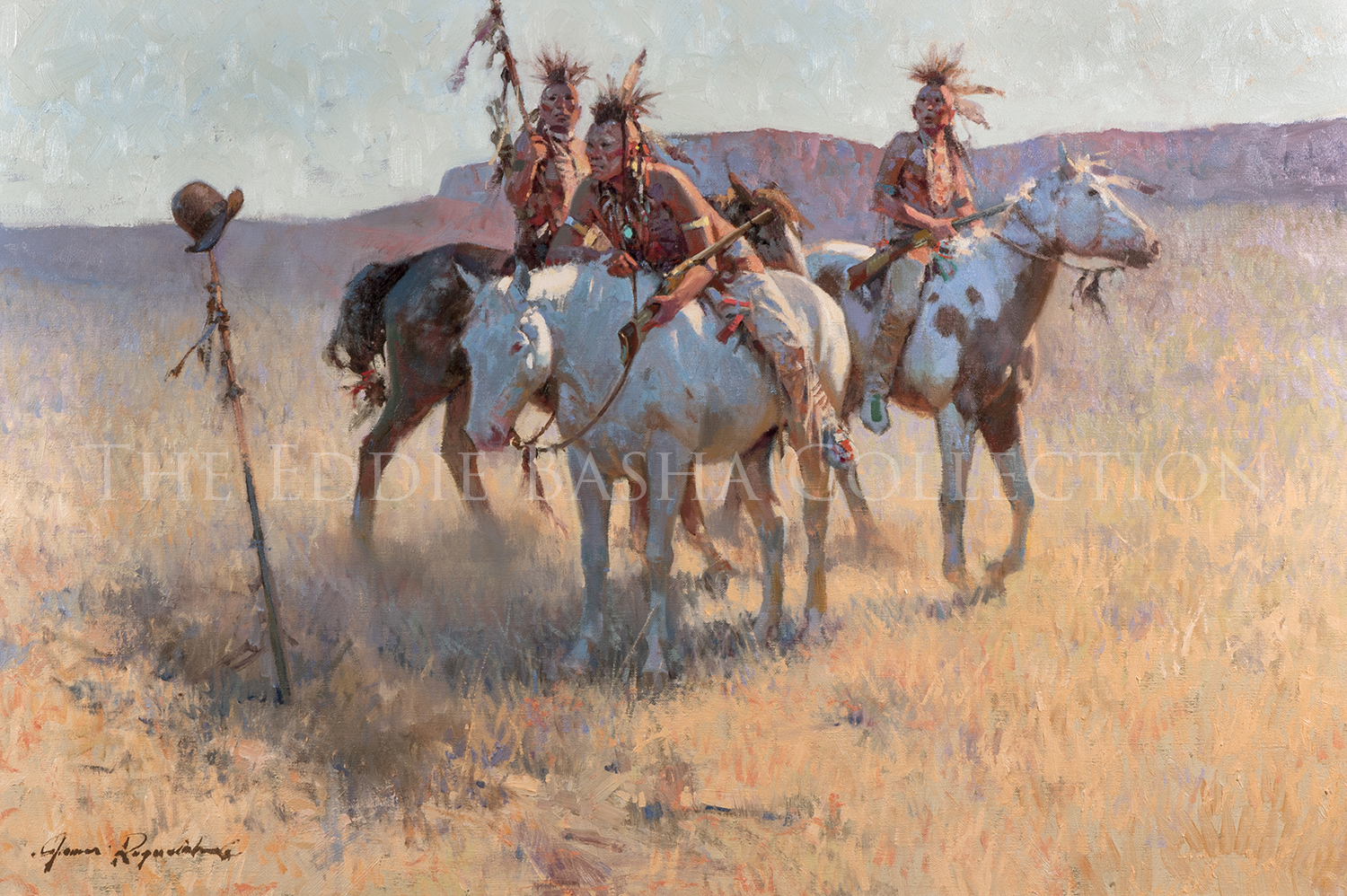
A Strange Sign
Artist: James Reynolds, CA (1926-2010)
Description: Oil | Image Size: 26”h x 36”w; Framed Size: 36”h x 48”wpainting
Reynolds did not flinch from portraying difficult subjects that were true to the history of the periods he depicted. This masterwork oil painting shows three Indians coming upon a warrior’s lance stuck in the ground with an unlucky soul’s hat atop, an indication that death was done here, without witness, in the silence of the sage. The rather bleak subject matter is emphasized by the parched and barren landscape captured in a muted palette, but one that employed many colors in subtle shadings. The figures of the horses and Indians are exceptionally well-drawn.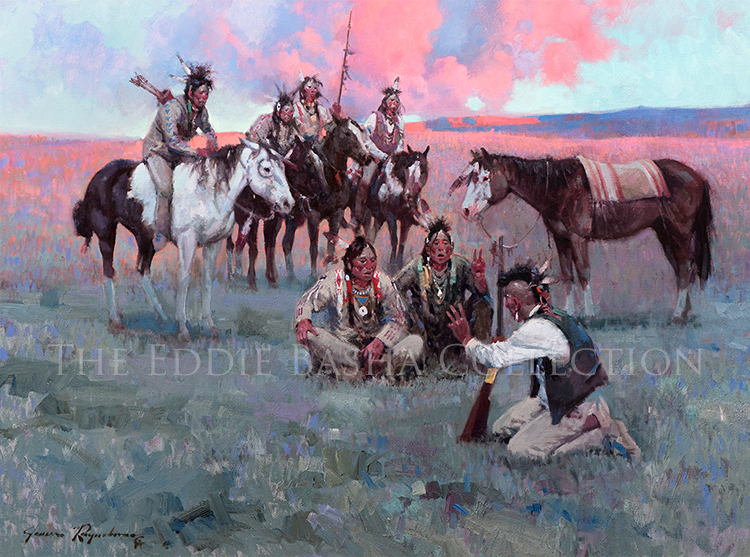
Thunder Stick
Artist: James Reynolds, CA (1926-2010)
Description: Oil | Image Size: 36”h x 48”w; Framed Size: 47”h x 59”wpainting
Firearms were superior in battle to the warrior’s traditional hand lance. A prized rifle might be captured from a fallen foe or obtained in a trade for horses. These traders are a horse apart from making a deal.
As one of James Reynolds’ major paintings … it is large, tells a compelling story, and illustrates his skill as a landscape painter who can master lighting and color as well as his talent for realistically depicting figures in an impressionistic style. Here a group of Plains Indians are examining a rifle that an Indian from a distant tribe has brought to trade. The group is arranged in a triangle with the trader at the point while a group of mounted Indians and a pony form the top side. The group is shown on a vast prairie with brilliant pink clouds, a Reynolds’ hallmark, in the center background. The pink light seems to wash over the entire background, while the foreground containing the figures is painted in cooler tones. We see the participants mid negotiation; the trader is pointing out the finer details of the rifle while his potential customers look on in rapt attention. Such a scene was most likely played out on these plains hundreds of times and Reynolds has perfectly captured the nuances of the potential deal and given the viewer a great sense of time and place. In this painting, Reynolds very effectively combines his talents as both a painter and storyteller.
Private collections, museums and galleries abound with James Reynolds work as well as the work of numerous other artists of the Western American genre. To find a museum in your area, visit www.museumswest.org for a complete listing!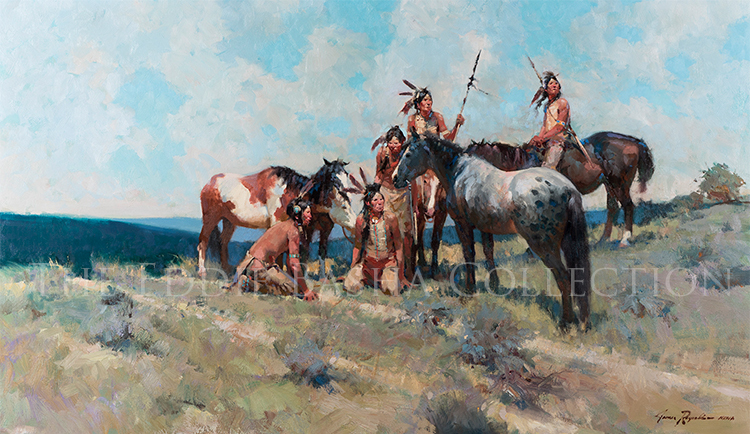
Unwelcome Tracks
Artist: James Reynolds, CA (1926-2010)
Description: Oil (1991) | Image Size: 28”h x 48”w; Framed Size: 38”h x 58”wpainting
In this painting, Reynolds has depicted prairie warriors examining the wheel ruts left by the passing wagon trains of Anglo immigrants. Their faces reflect concern and foreshadow the despair and tragedy for those who follow the buffalo and their way of life on the plains.
“Unwelcome Tracks” is a very good example of Reynolds’ mature style and is consistent with his known subject matter, palette, draftsmanship, execution, and sense of strongly narrative compositions. He has utilized a triangular grouping of figures and horses in the center of the canvas that serves to continuously redirect the viewers’ focus to the figures anchored in the landscape.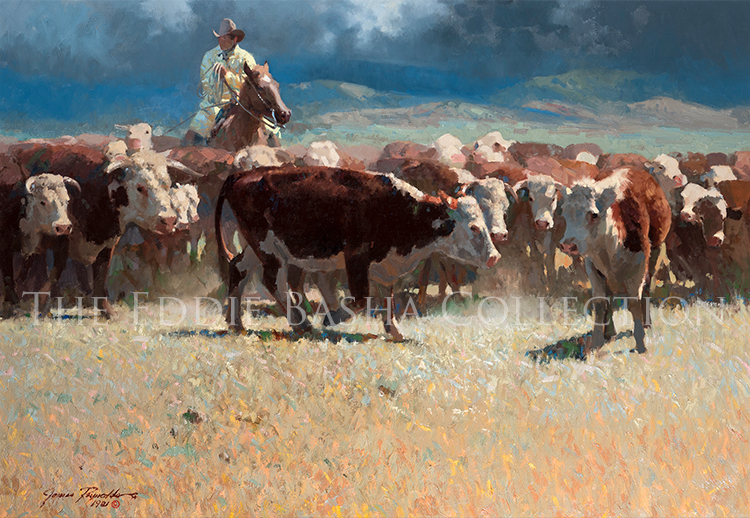
Winter Pasture
Artist: James Reynolds, CA (1926-2010)
Description: Oil (1981) | Image Size: 28”h x 40”w; 38 ½"h x 50 ½"wpainting
Working cattle can be a difficult and often dangerous business. It requires skill as a horseman, dexterity as a roper, and a thorough knowledge of animals that change direction and speed in a matter of seconds. “Winter Pasture” is an effective oil painting of the mechanics and potential drama inherent in this work.
Under a looming dark sky, Reynolds presents a cowboy working his herd and moving them into winter pasture. The cows occupy the middle ground of the painting and fill up the canvas presenting the viewer with a glimpse of the difficult tasks cowboys face such as commanding a herd of animals that may be spooked by an approaching storm or may stubbornly refuse to move. And since the cows are moving in and out of the scene, there is the sense that the cowboy is managing a far larger herd than is depicted. While the action of the painting is not frenetic, we do get an impression of constant motion, of being in the middle of a situation that could turn dicey.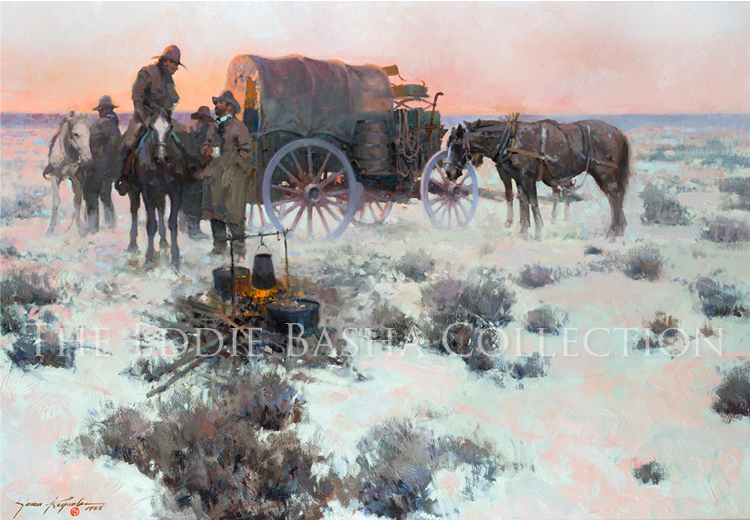
Cold Country, Hot Coffee
Artist: James Reynolds, CA (1926-2010)
Description: Oil (1985) | Image Size: 28”h x 40”w; Framed Size: 37”h x 49"wpainting
Artists often say that one of their intentions in producing a painting is to give the viewer a sense of being there, to make them feel the scene as well as see it. This painting of a small cow outfit heading out on a cold morning achieves that goal. The cowboys, horses, and wagon are bathed in the pink glow of the rising sun; the chill of the air is communicated by the snow-covered ground and the glow of the cookfire warming the coffee. Reynolds set just the right tone for his story to unfold in the viewer’s imagination.
“Cold Country, Hot Coffee” made its debut at the 20th Annual Cowboy Artists of America Exhibition & Sale in 1985 at the Phoenix Art Museum. Subsequently, it was loaned to The Thomas Gilcrease Institute of American History & Art (Tulsa, OK) for the Rendezvous 1993 Exhibition.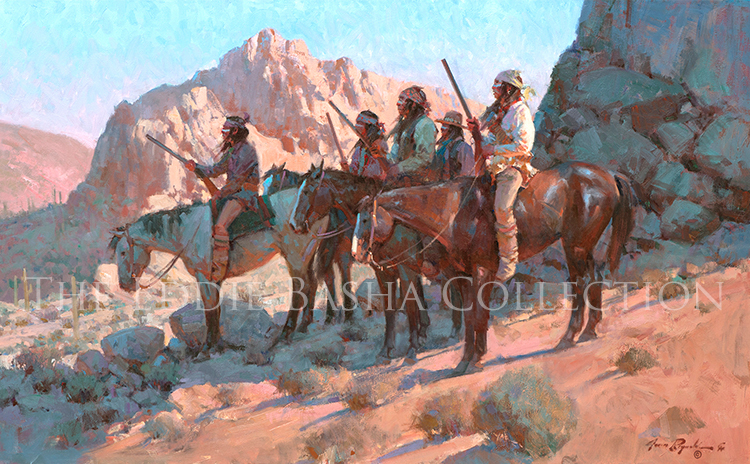
Chiricahua Stronghold
Artist: James Reynolds, CA (1926-2010)
Description: Oil | Image Size: 30”h x 48”w; Framed Size: 44.5”h x 62”wpainting
It is evident from much of James Reynolds’ work that he had a strong connection to the American Southwest—it’s history, landscape, and people. All of those elements are on display in this painting of a group of mounted Chiricahua Apaches shown in bright sunlight against the rugged high desert landscape of their native land. The Apache and their horses are painted in vivid colors with authentic late nineteenth century details of dress and weaponry. The harsh, yet beautiful environment is depicted with a true impression of the arid climate. Reynolds has placed his subjects on a downward slope in the center of the painting poised in the shade cast by a large boulder behind them. He effectively contrasts the coolness of the shadow with the heat and brightness of the surrounding desert. In this painting, Reynolds’ talent as a landscapist and figure painter are on equal display.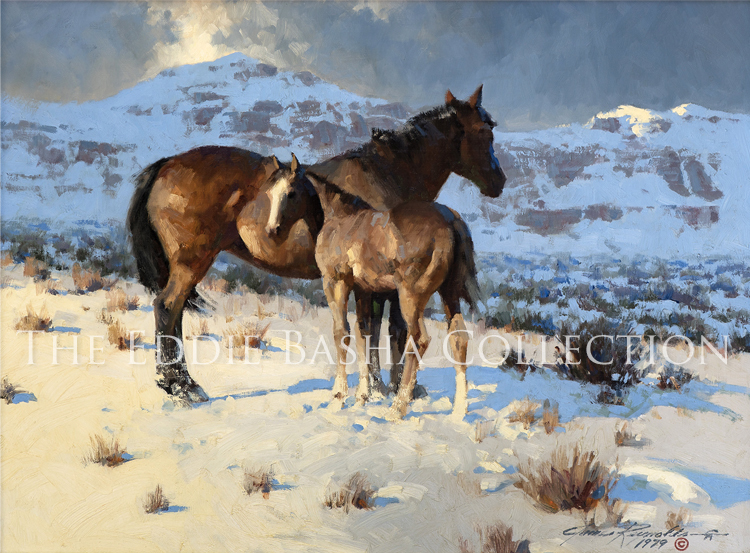
Mare and Colt
Artist: James Reynolds, CA (1926-2010)
Description: Oil on Board (1979) | Image Size: 18”h x 24”w; Framed Size: 28”h x 34”wpainting
Once again, James Reynolds demonstrated his mastery at conveying a mood through a vivid depiction of a winter landscape. However, in this painting of a mare and her colt, the mood is not somber or desolate. The ground is covered with snow, but the horses are standing in a patch of bright sunlight and the mother’s protective stance appears to be shielding her colt from the coming chill of the night. There is definite affection between the two.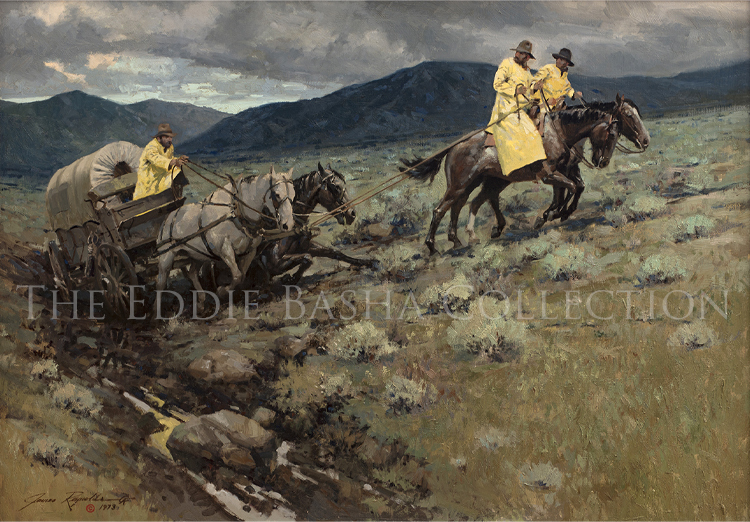
A Helpin’ Hand
Artist: James Reynolds, CA (1926-2010)
Description: Oil (1973) | Image Size: 28”h x 40”wpainting
James Reynolds used a simple, but very effective, compositional device to focus the viewer’s attention on the heart of this painting, a triangle. The point of the triangle is formed by the wagon and team of horses and the sides are formed by the gully, which leads from the wagon to the foreground, and the wagon and two riders who are moving toward the upper right of the canvas. The cowboys’ yellow slickers also serve to keep our attention on the action at hand. As always, Reynolds set the action of the painting against a compelling landscape that created a palpable atmosphere, placing the viewer in a specific time and place, and exacting a genuine feel of working in inclement weather to get a difficult job done.
“A Helpin’ Hand” made its debut at the 8th Annual Cowboy Artists of America Exhibition & Sale held at the Phoenix Art Museum in 1973.
The Hunt
Artist: James Reynolds, CA (1926-2010)
Description: Oil (1998) | Image Size: 36”h x 48”w; Framed Size: 46”h x 58”wpainting
A long time ago, huge herds of buffalo grazed upon the broad western prairies. It was the very heart of the cultures and traditions of the great plains. The hunt for the great beasts meant survival for the prairie people. Slowly but surely through the efforts of many, the great herds are being reestablished.
James Reynolds captured the drama, excitement, action and even the chaos of a buffalo hunt by a group of mounted Plains Indians who display both their horsemanship and prowess as hunters using bows and arrows. Reynolds has created a scene of intense action and movement, but he has also been careful to include authentic details of the period, such as the handprint on the leading Indian’s white horse, a sign that this individual has touched an opponent in battle. The action is set against a parched and rolling prairie landscape underneath a cloud filled blue sky. While the dust cloud from the riders and herd obscures the trailing Indians and animals, the leading players are shown in clear detail.
Like many of his predecessor artists, most notably Charles M. Russell, Reynolds found in the buffalo hunt a subject that has universal appeal illuminating both the bravery and skill of the hunters and the magnificence of the hunted.
This piece was first exhibited at the Prix de West Invitational held at the National Cowboy & Western Heritage Museum in Oklahoma City, OK, and subsequently found its home in The Eddie Basha Collection. In 2022, it was loaned to the Briscoe Western Art Museum in San Antonio, TX, for the “Sons of Charlie Russell: Cowboy Artists of America” exhibition. And, once the expansion area of Western Spirit: Scottsdale Museum of the West is complete, “The Hunt” will be exhibited in its new surroundings.
Chiricahua Mountains
Artist: James Reynolds, CA (1926-2010)
Description: Oil | Image Size: 12”h x 16”w; Framed Size: 25”h x 29”wpainting
Color, light, shadow, and texture are all essential elements of a finely done landscape. James Reynolds shows his expertise with all in this vista. The shadows and deep colors of the forested foreground gradually lighten as the viewer’s eye is lured upward by the alluring mountains in the background. Though a small image, it manages to project a sense of grandeur.
The Chiricahua Mountains are a large mountain range in southeastern Arizona; the range is part of the Coronado National Forest. The highest point, Chiricahua Peak, rises 9,759 feet above sea level, approximately 6,000 feet above the surrounding valleys.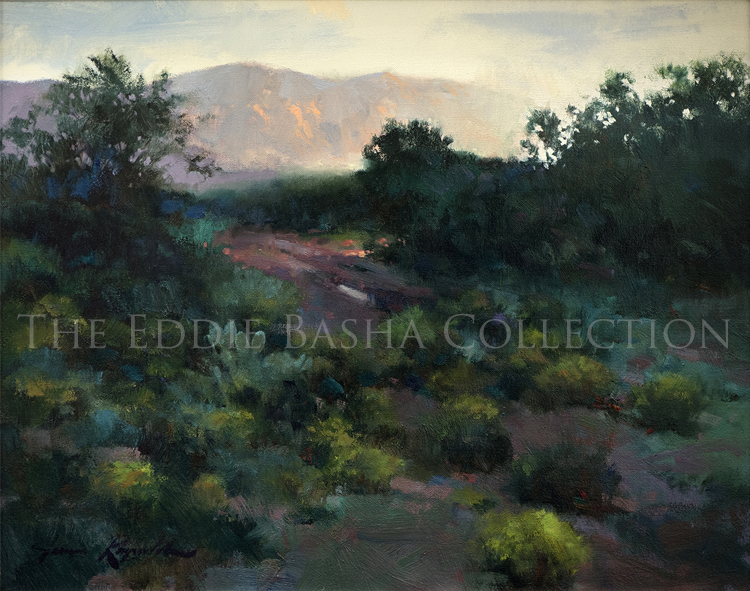
After the Rain
Artist: James Reynolds, CA (1926-2010)
Description: Oil (1991) | Image Size: 16”h x 20”w; Framed Size: 19”h x 23”wpainting
Throughout much of James Reynolds’ career, he was known for his narrative paintings about the West, but those paintings also revealed his amazing talent as a landscape painter. Toward the end of his career, much of his time was spent painting the landscapes he was passionate about: deserts, prairies, mountains, lakes and rivers, forests, and seasonal changes upon those terrains. He found solace in the beauty and bounty of nature.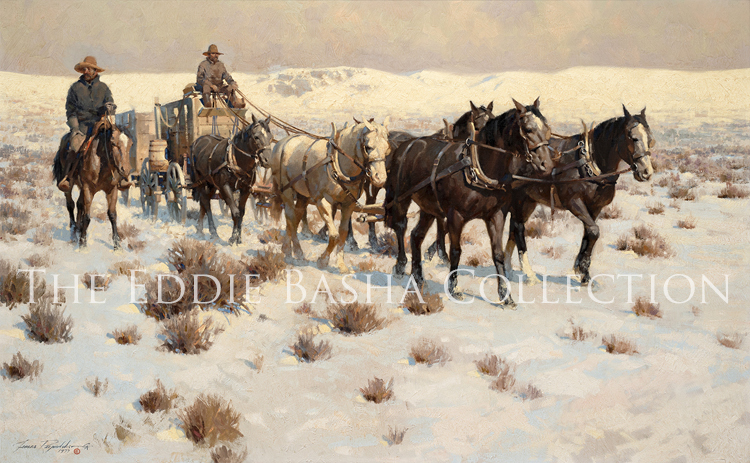
The Freighter
Artist: James Reynolds, CA (1926-2010)
Description: Oil (1977) | Image Size: 30”h x 48”w; Framed Size: 40”h x 58”wpainting
Commerce in the early west rolled upon iron-rimmed wagon wheels. Lured westward by the promise of profit in far flung outposts of civilization, tough men took up the challenge of danger and distance. And James Reynolds told the story well and provided the narrative elements of the cowboys, the team of six horses and the freighter on their frozen journey, but he also added visual details that contributed to the drama unfolding. The band of gray sky above the snowcapped mountains gives way to the bluish white snow of the terrain providing viewers with a realistic feel for the weather and the atmosphere of the day. The riders make their way toward the sun which casts a glancing light that is reflected off the wagon and the white horse at the center of the wagon team—that subtle addition serves to fix the viewer’s eye on the center of the painting. The entire canvas is covered with cool colors that emphasize the cold and winter weather. All of these visual elements move the story along, but also inspire an emotional response.
Good Grass
Artist: James Reynolds, CA (1926-2010)
Description: Oil | Image Size: 18”h x 24”w; Framed Size 26 ¾"h x 32 ¾"wpainting
James Reynolds’ artistry as both a figure painter and a landscapist are on full display in “Good Grass”. Naturally, the bison group is painted harmoniously with
the surrounding landscape. The good grass of the painting’s title composes three quarters of the painting while the rest of the canvas is composed of bands of colors in the background; a dark, green line of trees is placed behind the buffalo and is topped
with a bluish mountain chain and a pale blue sky filled with white clouds completing the scene. These disparate colors blend well to form the perfect backdrop for the grazing animals.
The Changeover
Artist: James Reynolds, CA (1926-2010)
Description: Oil (1976) | Image Size: 28”h x 40”w; Framed Size: 39”h x 51”wpainting
A stagecoach stopped on a snow covered route under a dark, overcast sky captures the harsh realities of a winter’s aura as well as the extraordinary capacities of both man and mammal that went into moving a stage across difficult terrain. The front wheel position, the coachman’s angled footboard, the slackened reigns, and the well placed horizon speak to not only the authenticity of the era, but are a testament to the artist’s expertise. Lighting, landscapes, and history… James Reynolds was indeed a triple threat.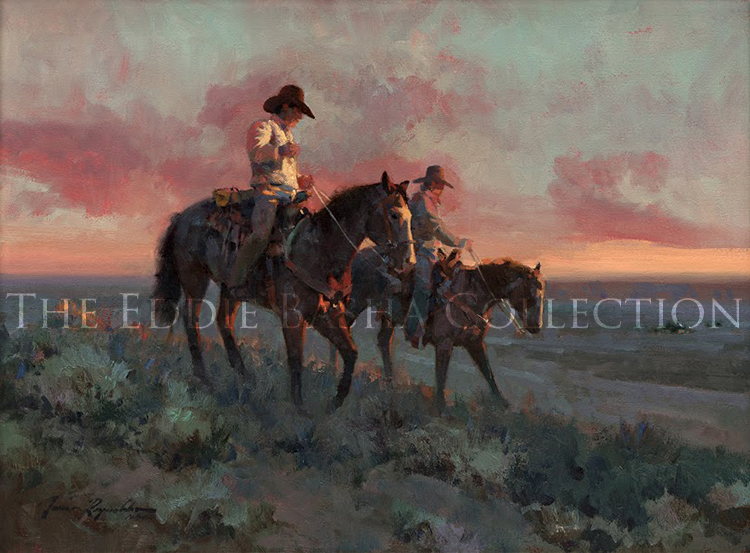
Almost Home
Artist: James Reynolds, CA (1926-2010)
Description: Oil (1991) | Image Size: 18”h x 24”w; Framed Size: 28”h x 34”wpainting
James Reynolds was born in a Standard Oil lease house in 1926 and raised in Taft, California. He spent summers at his grandmother’s Nevada City hotel which was situated just beyond the infamous Donner Pass and literally above the south fork of the Yuba River. During those formative years, he heard many stories of the old West and developed a lifelong fascination with western history. Although he dabbled in art during grade school, Reynolds didn’t investigate being an artist seriously until after his service in the World War II Pacific theatre.
He enrolled in the Kann Institute of Art in Beverly Hills, CA, for one year and then attended the School of Allied Arts in Glendale, CA, for four. Following, he found work in Hollywood. For a decade and a half he sketched storyboards and sets for most of the major studios. After a particularly grueling assignment designing and helping to apply a body of tattoos on actor Rod Steiger for the film version of “The Illustrated Man,” which was photographed by Life Magazine, Reynolds moved to Sedona to devote his time painting images of the historic and contemporary West.
Few artists ever receive the honor of becoming known as a “painter’s painter.” Reynolds is one such artist. A master colorist and born storyteller, Reynolds is often cited by other artists as one who consistently combines all the elements of composition, color and atmosphere into masterful paintings. Reynolds is as adept at painting cowboys working a herd of cattle as he is at capturing the beauty of an Arizona sunset. One of his fellow artists said, “Any painter who wants to learn how to really nail a picture of the west, whether it is the Old West or a scene right out of yesterday, would do well to take a hard look at James Reynold’s work. He gets all of the ingredients right and he does it with a style that is his alone.”
Reynolds often said that great art is born of a keen sense of observation. An artist, he said, has to be adept at truly seeing the landscape around him. As is clear from his work, Reynolds was committed to painting the strong vibrant colors of the West, but he was also adamant that those colors match the exact values that are found in nature. Reynolds was so successful in achieving these goals that his work has become a model for contemporary artists.
Reynolds became a member of the Cowboy Artists of America in 1968 and received top honors the same year he left Hollywood. He was the first artist to win the Prix de West Invitational award, the Buyer’s Choice award, and the Gold Medal for painting at the National Academy of Western Art in Oklahoma City.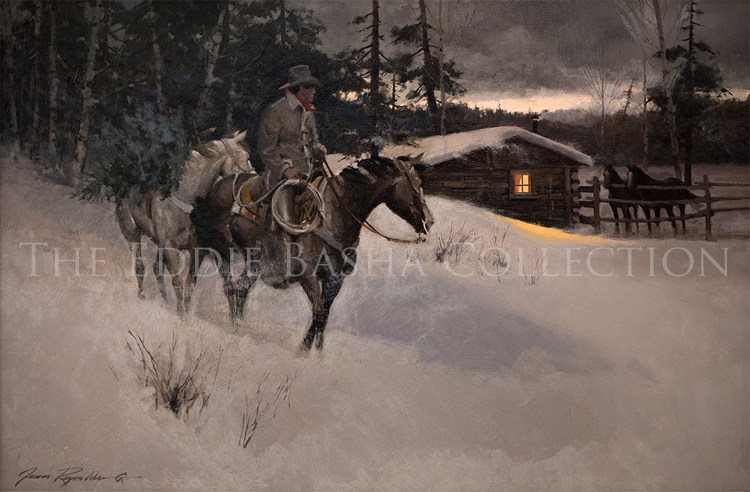
Comin’ Home for Christmas
Artist: James Reynolds, CA (1926-2010)
Description: Oil | Image Size: 20”h x 30”w; Framed Size: 29 ¼”h x 39”wpainting
Through the contours of the snow covered ground, the cowboy leads his Christmas tree laden pack horse toward the cabin and corral in the background. The single window lit from within conveys the warmth and comfort that soon awaits. Reynolds has led viewers along with the cowboy into the cabin and into the story as well.
Aunt Zelma’s Friends
Artist: James Reynolds, CA (1926-2010)
Description: Oil | Image Size: 28”h x 40”w; Framed Size: 38 ½”h x 50 ½”wpainting
While Aunt Zelma and Eddie were visiting James Reynolds in his studio one day, this piece was on his easel. When Eddie inquired as to what it would be titled, Jim, the occasional curmudgeon barked, “I don’t know” and later flippantly said he would call it “Aunt Zelma’s Friends.” It was a gesture of friendship and in appreciation for her admiration and support of him that Jim Reynolds titled this piece accordingly since Aunt Zelma made no secret of the fact that he was her favorite of the contemporary Western artists.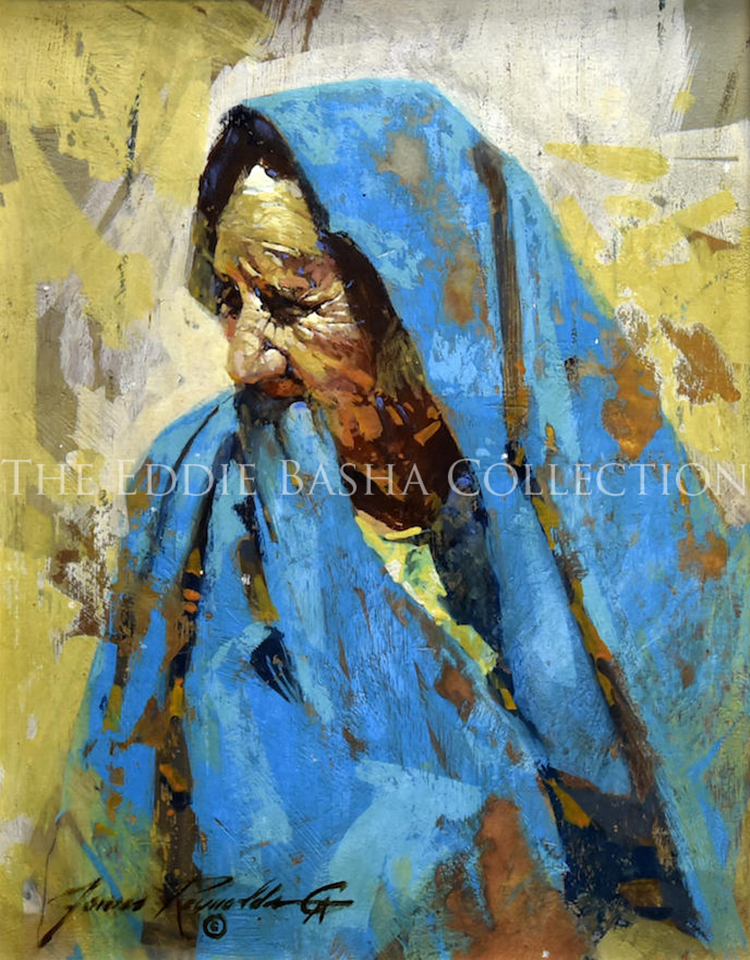
Untitled
Artist: James Reynolds, CA (1926-2010)
Description: Oil on Panel | Image Size: 14”h x 11”wpainting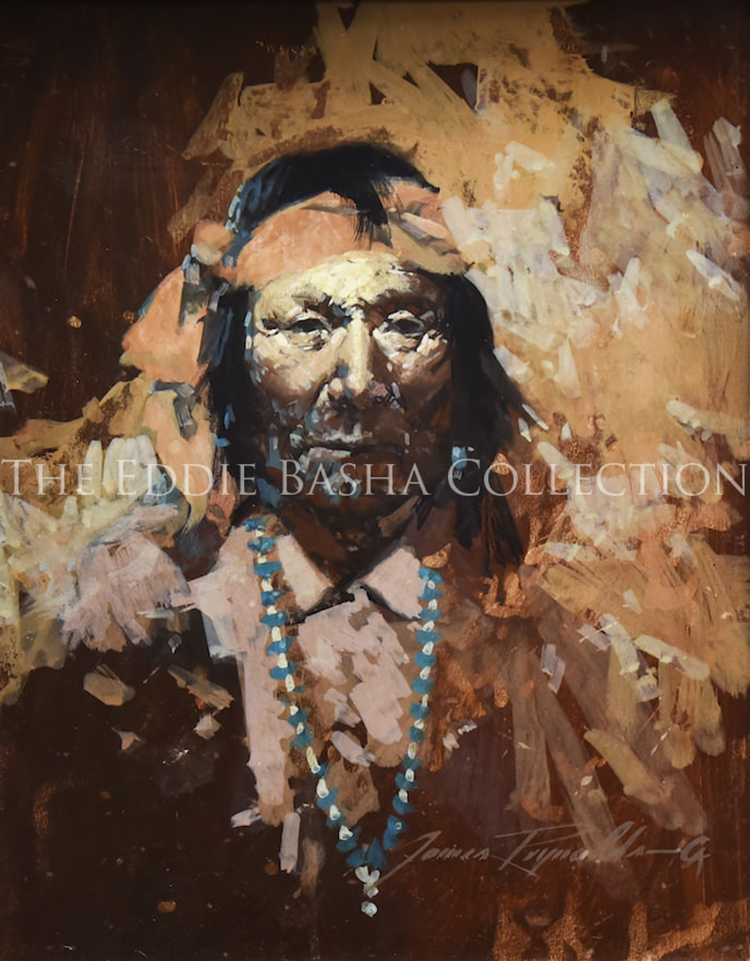
Untitled
Artist: James Reynolds, CA (1926-2010)
Description: Oil on Panel | Image Size: 14”h x 12”wpainting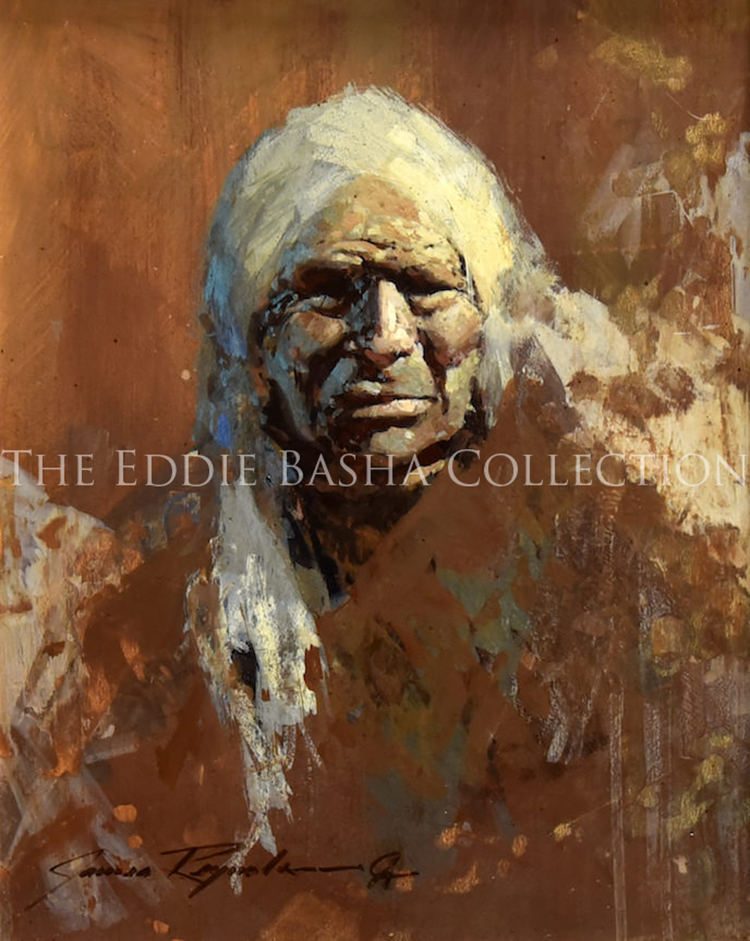
Untitled
Artist: James Reynolds, CA (1926-2010)
Description: Oil on Panel | Image Size: 14”h x 12”wpainting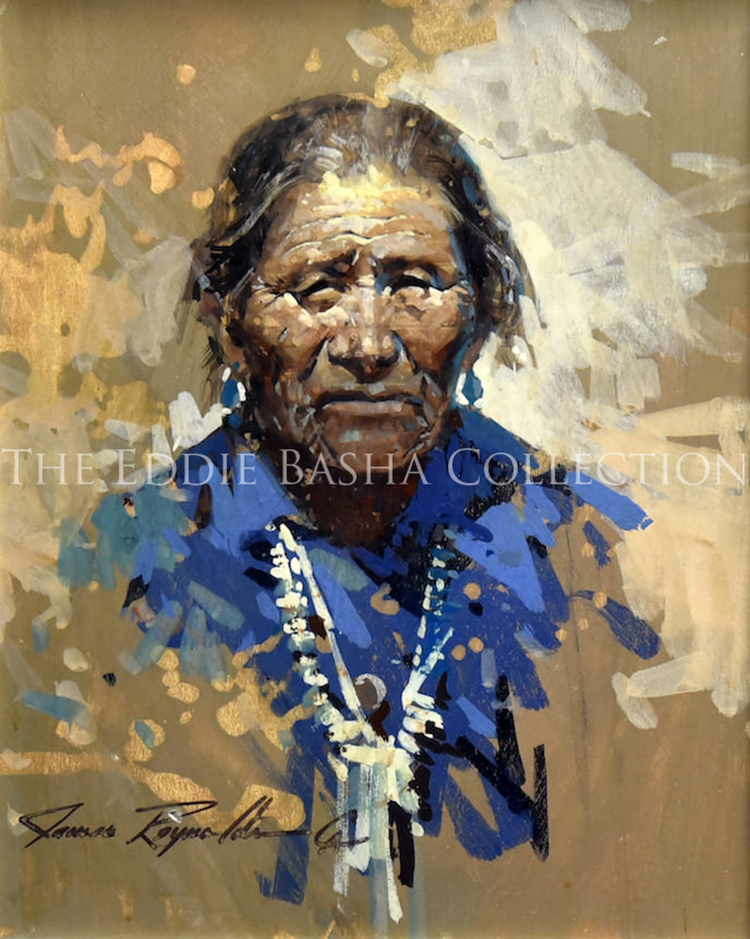
Untitled
Artist: James Reynolds, CA (1926-2010)
Description: Oil on Panel | Image Size: 14”h x 12”wpainting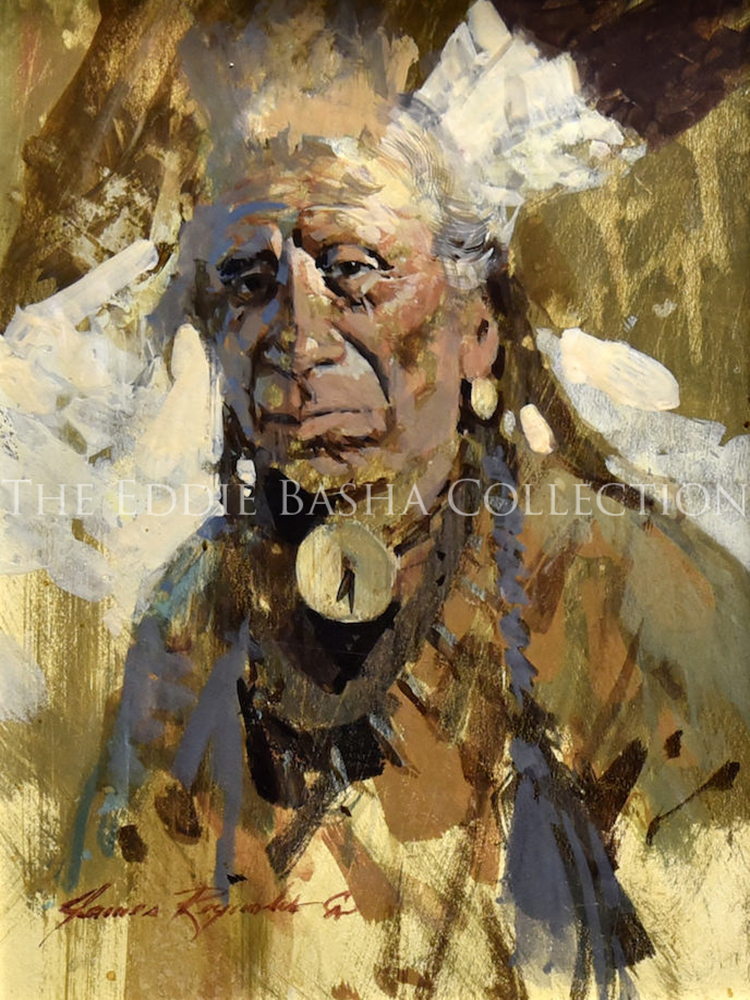
Untitled
Artist: James Reynolds, CA (1926-2010)
Description: Oil | Image Size: 12”h x 9”wpainting
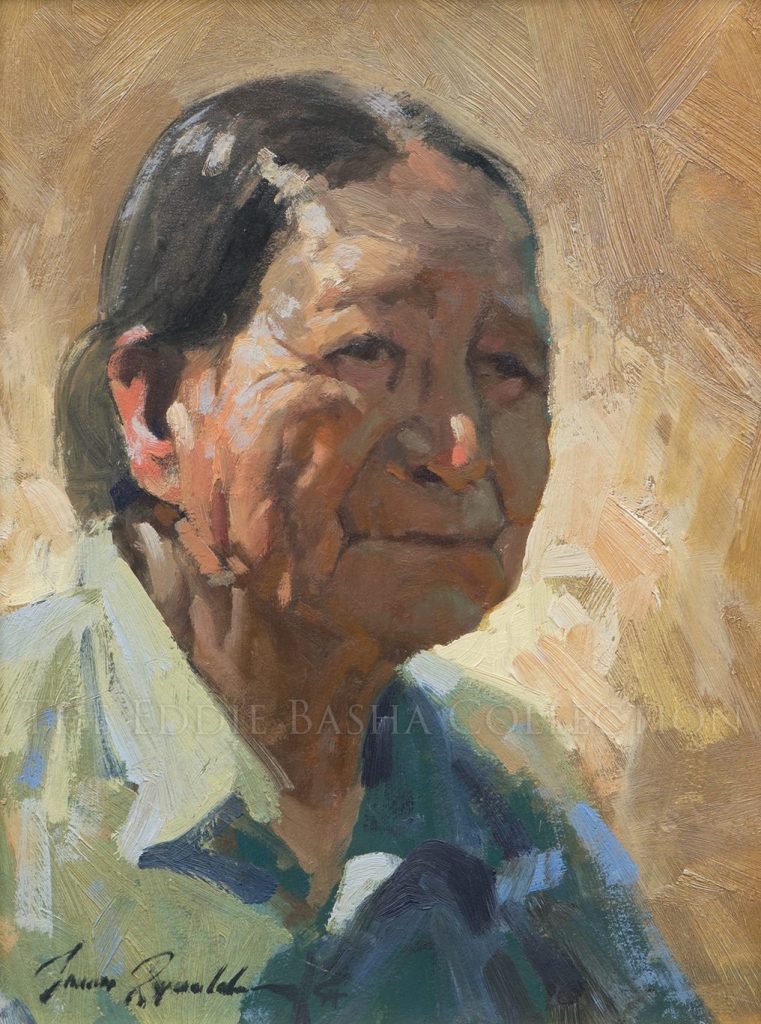 Oil | Image Size: 12h x 9”w; Framed Size: 20 ½”h x 17”w
Oil | Image Size: 12h x 9”w; Framed Size: 20 ½”h x 17”w Better known for his landscapes, modern ranching scenes, and historical narratives, James Reynolds also excels at portraiture as this small painting attests. Bold and vibrant brush strokes are used to effectively capture the personality and essence of the subject. His face is seen at a slight profile with the light source to his left. Age lines around the chief’s eyes add a touch of authenticity and realism to this impressionistic portrait.
Taos Chief
Artist: James Reynolds, CA (1926-2010)
Better known for his landscapes, modern ranching scenes, and historical narratives, James Reynolds also excels at portraiture as this small painting attests. Bold and vibrant brush strokes are used to effectively capture the personality and essence of the subject. His face is seen at a slight profile with the light source to his left. Age lines around the chief’s eyes add a touch of authenticity and realism to this impressionistic portrait.
 Oil (1991) | Image Size: 24”h x 36”w; Framed Size: 34”h x 46”w
Oil (1991) | Image Size: 24”h x 36”w; Framed Size: 34”h x 46”w“On the Edge” combines two of James Reynolds’ favorite subjects, the cowboy and the Arizona landscape. The cowboy riding along the edge of a vast canyon is lit by the same sunlight that washes across the landscape. The pink light reflected in his clothing is the same color that is reflected by the canyon walls in the far distance which brings a sense of continuity to the entire painting. The cowboy and his horse are riding toward the sun and are shown in high relief, as is the ground around them. The details of the cowboy’s clothing and gear are easily seen and the ground beneath them is equally detailed. As the viewer’s eye continues to take in the rest of the scene, hard details become less distinct in the same fashion that one would notice were he standing on the rim of a canyon gazing across a vast chasm. Reynolds is certainly skilled as a figure painter, but this painting reminds us that he may well have been an even better landscape painter.
On the Edge
Artist: James Reynolds, CA (1926-2010)
“On the Edge” combines two of James Reynolds’ favorite subjects, the cowboy and the Arizona landscape. The cowboy riding along the edge of a vast canyon is lit by the same sunlight that washes across the landscape. The pink light reflected in his clothing is the same color that is reflected by the canyon walls in the far distance which brings a sense of continuity to the entire painting. The cowboy and his horse are riding toward the sun and are shown in high relief, as is the ground around them. The details of the cowboy’s clothing and gear are easily seen and the ground beneath them is equally detailed. As the viewer’s eye continues to take in the rest of the scene, hard details become less distinct in the same fashion that one would notice were he standing on the rim of a canyon gazing across a vast chasm. Reynolds is certainly skilled as a figure painter, but this painting reminds us that he may well have been an even better landscape painter.
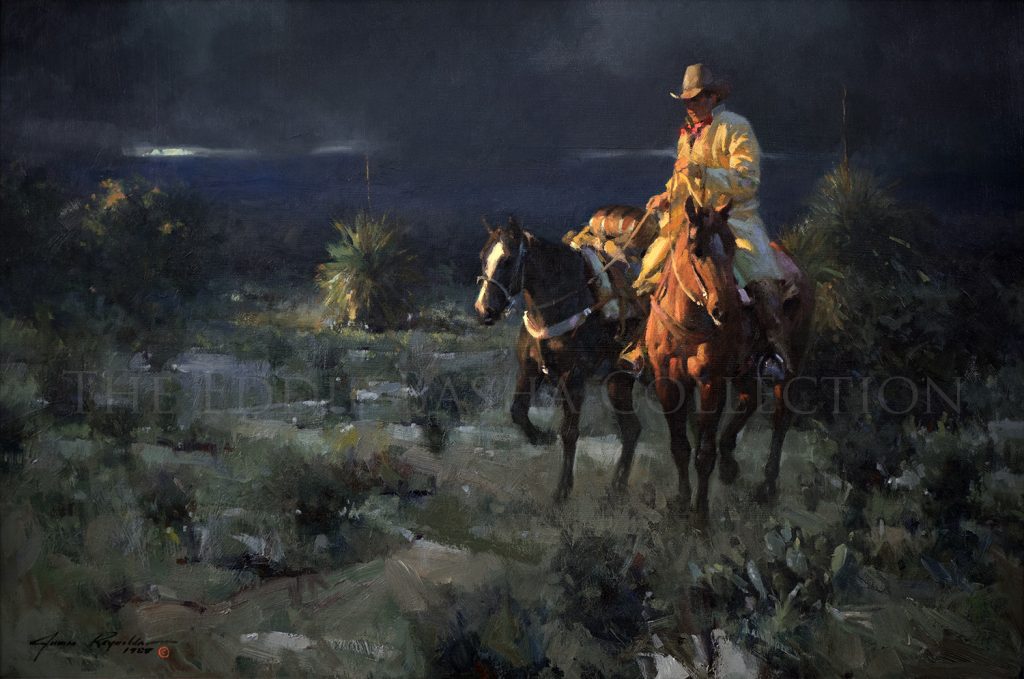 Oil (1985) | Image Size: 24”h x 36”w; Framed Size: 34 5/8”h x 46 3/8”w
Oil (1985) | Image Size: 24”h x 36”w; Framed Size: 34 5/8”h x 46 3/8”wThis relatively large James Reynolds oil captures the urgency of a cowboy putting distance between himself and his mounts and a threatening thunderstorm in the background. The cowboy has just ridden into a patch of light, probably the last rays of sunshine he will feel before the storm hits. “Sabino Canyon” was loaned to the Thomas Gilcrease Institute of American History & Art in Tulsa (OK) April-July 1993, for the Rendezvous 1993 Exhibition.
“Sabino Canyon is located within the Santa Catalina Mountains in the Coronado National Forest and is a part of the Sonoran Desert. The canyon is just outside the Tucson AZ city limits.
The Santa Catalina Mountains began forming 12 million years ago. The movement of the mountains created the mountain peaks as well as the basin, or bowl-shaped land, on which the city of Tucson is built. This movement of the mountain range stopped about 5 million years ago. The land formation is called Basin and Range. Approximately 8,000 years ago the first saguaros began growing in the canyon and about 4,000 years ago the first paloverde trees took root in the canyon. There is evidence in pieces of pottery, or shards, and pit house foundations that the Hohokam people lived in the canyon between 300 and about 1400 AD. With the Gadsden Purchase in 1854, Sabino Canyon became part of the United States.
The area is managed by the Forest Service. Their jobs include maintaining the canyon as a recreation area and learning center, protecting the creek, soil, and wildlife, and managing the relationship between Tucson and the canyon, including controlling fires and floods. Sabino Canyon is a treasure for Tucson residents and tourists alike.” Resource: https://sabinocanyon4kids.com/history.html . Visitor information can be found at https://www.fs.usda.gov/coronado
Sabino Canyon
Artist: James Reynolds, CA (1926-2010)
This relatively large James Reynolds oil captures the urgency of a cowboy putting distance between himself and his mounts and a threatening thunderstorm in the background. The cowboy has just ridden into a patch of light, probably the last rays of sunshine he will feel before the storm hits. “Sabino Canyon” was loaned to the Thomas Gilcrease Institute of American History & Art in Tulsa (OK) April-July 1993, for the Rendezvous 1993 Exhibition.
“Sabino Canyon is located within the Santa Catalina Mountains in the Coronado National Forest and is a part of the Sonoran Desert. The canyon is just outside the Tucson AZ city limits.
The Santa Catalina Mountains began forming 12 million years ago. The movement of the mountains created the mountain peaks as well as the basin, or bowl-shaped land, on which the city of Tucson is built. This movement of the mountain range stopped about 5 million years ago. The land formation is called Basin and Range. Approximately 8,000 years ago the first saguaros began growing in the canyon and about 4,000 years ago the first paloverde trees took root in the canyon. There is evidence in pieces of pottery, or shards, and pit house foundations that the Hohokam people lived in the canyon between 300 and about 1400 AD. With the Gadsden Purchase in 1854, Sabino Canyon became part of the United States.
The area is managed by the Forest Service. Their jobs include maintaining the canyon as a recreation area and learning center, protecting the creek, soil, and wildlife, and managing the relationship between Tucson and the canyon, including controlling fires and floods. Sabino Canyon is a treasure for Tucson residents and tourists alike.” Resource: https://sabinocanyon4kids.com/history.html . Visitor information can be found at https://www.fs.usda.gov/coronado
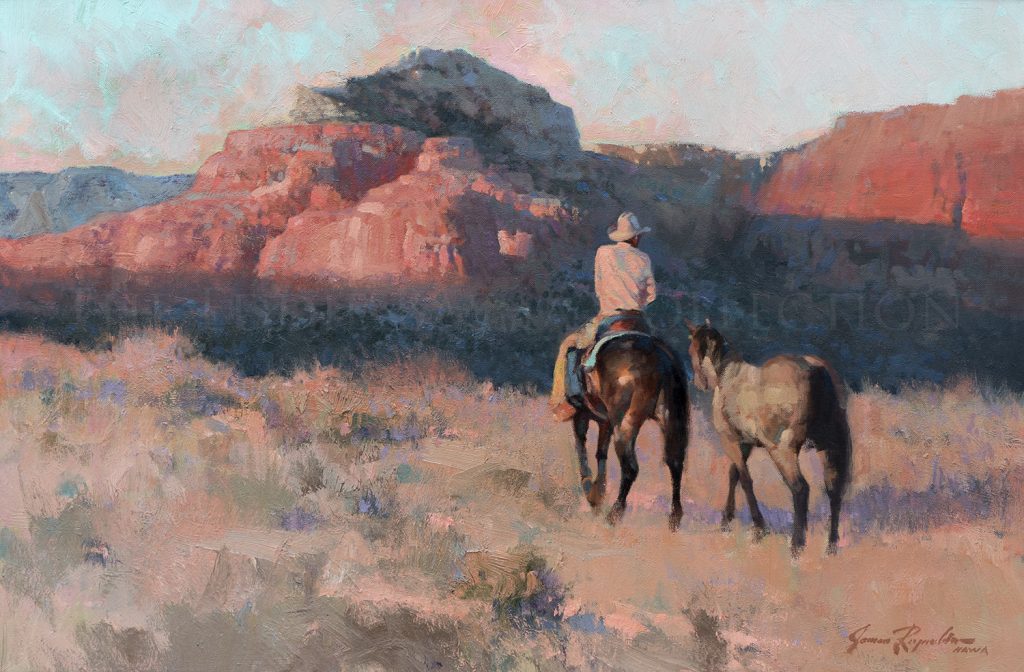 Oil (1991) | Image Size: 20”h x 30”w; Framed Size: 30 ½”h x 40”w
Oil (1991) | Image Size: 20”h x 30”w; Framed Size: 30 ½”h x 40”wIn this oil painting of a mounted cowboy leading another horse away from the viewer, James
Reynolds shows his skill as an impressionistic landscape painter. The painting is as much about shadings of light, color, tone, and texture as it is about the figures of horses and rider. By turning the figures’ backs to the viewer, Reynolds emphasizes that he has concentrated on creating a painting that is evocative of a certain time of day and location. It is the transition between sunlight and shadow, from the muted tones of the foreground to the dark band of shadowed ground in front of the rider, and finally to the red rocks and pale blue sky of the background, that has most captured the artist’s imagination. His intent, which he has masterfully succeeded at, is to create a mood that conveys his feeling for the land and the beauty of nature. As in many of his paintings, color and light are the stars of this canvas.
In case you were wondering, in Arizona “rim country” typically refers to the Mogollon which cuts across the northern half of Arizona extending approximately 200 miles beginning in Yavapai County and extended eastward toward the New Mexico border forming the southern edge of the Colorado Plateau.
Rim Country
Artist: James Reynolds, CA (1926-2010)
In this oil painting of a mounted cowboy leading another horse away from the viewer, James
Reynolds shows his skill as an impressionistic landscape painter. The painting is as much about shadings of light, color, tone, and texture as it is about the figures of horses and rider. By turning the figures’ backs to the viewer, Reynolds emphasizes that he has concentrated on creating a painting that is evocative of a certain time of day and location. It is the transition between sunlight and shadow, from the muted tones of the foreground to the dark band of shadowed ground in front of the rider, and finally to the red rocks and pale blue sky of the background, that has most captured the artist’s imagination. His intent, which he has masterfully succeeded at, is to create a mood that conveys his feeling for the land and the beauty of nature. As in many of his paintings, color and light are the stars of this canvas.
In case you were wondering, in Arizona “rim country” typically refers to the Mogollon which cuts across the northern half of Arizona extending approximately 200 miles beginning in Yavapai County and extended eastward toward the New Mexico border forming the southern edge of the Colorado Plateau.
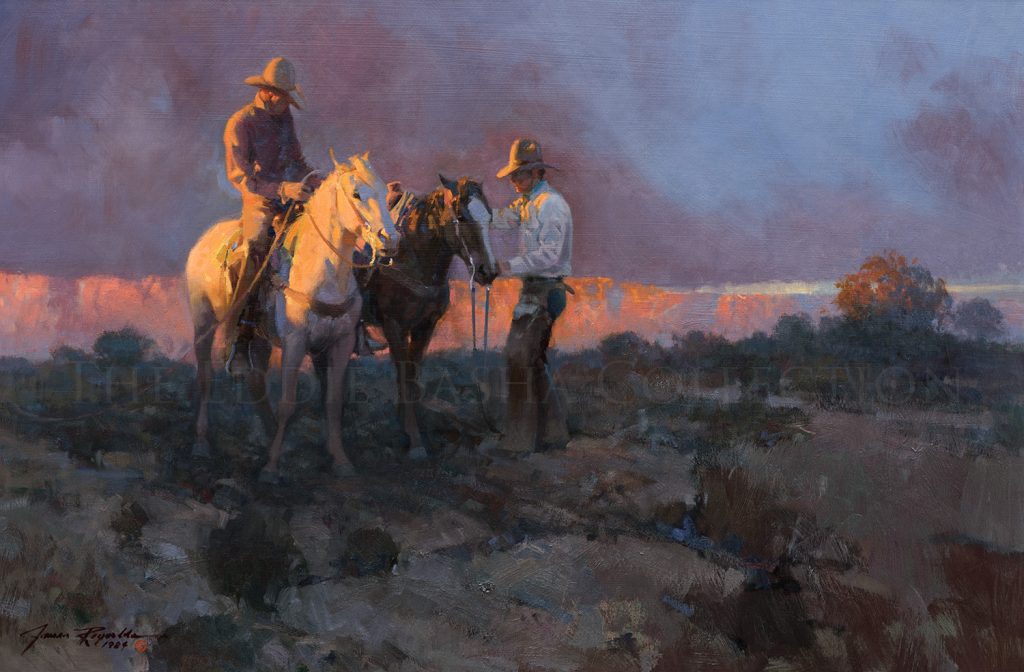 Oil | Image Size: 24”h x 36”w; Framed Size: 34 ½:h x 46 ½”w
Oil | Image Size: 24”h x 36”w; Framed Size: 34 ½:h x 46 ½”w“On the Mogollon” by CAA artist James Reynolds is a relatively simple scene in terms of its subject: two cowboys pause in their travels while one of them dismounts to adjust his horse’s bridle. One cowboy remains mounted and watches his friend’s progress. However, the subject of the painting is the only element that is simple. The surrounding landscape is spectacular; the cowboys are traveling along the rim of a deep canyon with an immense desert falling away into the background. The use of sunlight in the painting dramatically enhances every facet of the scene; shimmering off the white horse and white shirt of the dismounted rider while illuminating and bathing the canyon in a pink, orange, and purple glow. Reynolds’ impressionistic technique of soft edges, subtle blending of colors, and above all his masterful handling of light perfectly evokes a fleeting moment frozen in time.
The Mogollon Rim in Northern Arizona stretches 200 miles from Yavapai County to New Mexico and provides spectacular views overlooking an expansive forest of pine trees. The rim is a true geological wonder. The inhabitants of Arizona, past and present, as well as a plethora of visitors have enjoyed “Rim” country’s many splendors … hunting, fishing, horseback riding, stargazing, rock climbing, bird watching, hiking, bike riding, and picnicking.
On the Mogollon
Artist: James Reynolds, CA (1926-2010)
“On the Mogollon” by CAA artist James Reynolds is a relatively simple scene in terms of its subject: two cowboys pause in their travels while one of them dismounts to adjust his horse’s bridle. One cowboy remains mounted and watches his friend’s progress. However, the subject of the painting is the only element that is simple. The surrounding landscape is spectacular; the cowboys are traveling along the rim of a deep canyon with an immense desert falling away into the background. The use of sunlight in the painting dramatically enhances every facet of the scene; shimmering off the white horse and white shirt of the dismounted rider while illuminating and bathing the canyon in a pink, orange, and purple glow. Reynolds’ impressionistic technique of soft edges, subtle blending of colors, and above all his masterful handling of light perfectly evokes a fleeting moment frozen in time.
The Mogollon Rim in Northern Arizona stretches 200 miles from Yavapai County to New Mexico and provides spectacular views overlooking an expansive forest of pine trees. The rim is a true geological wonder. The inhabitants of Arizona, past and present, as well as a plethora of visitors have enjoyed “Rim” country’s many splendors … hunting, fishing, horseback riding, stargazing, rock climbing, bird watching, hiking, bike riding, and picnicking.
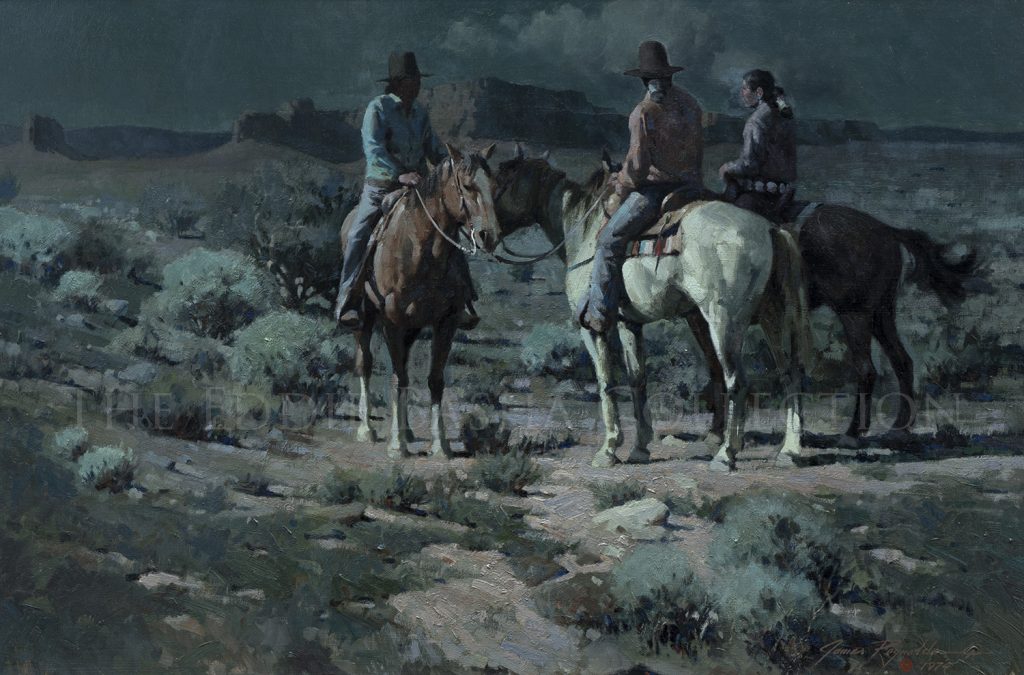 Oil (1974) | Image Size: 24”h x 36”w; Framed Size: 33”h x 45”w
Oil (1974) | Image Size: 24”h x 36”w; Framed Size: 33”h x 45”wIn this painting, James Reynolds once again demonstrates his skill with nocturnals. His blending of colors and shades, his depiction of varying textures, and his handling of a glancing moonlight as his chief source of light combine to produce a highly effective scene that captures the spirit of the moment. Three Navajo riders have paused on their journey; two appear to be traveling together while a third rider seems to have met them on the trail. They are shown in the glow of the moonlight, which is primarily reflected off of the white horse in the center of the painting, while the rest of the canvas is painted in dark and muted tones. The action of the painting is very quiet, as is befitting of the moment being depicted. We do not know why these riders have stopped, nor do we know if they are engaging in a conversation—-that part of the painting remains a mystery, but we do feel the quietness and serenity of the night.
“Navajos” made its debut at the 9th Annual Cowboy Artists of America Exhibition at the Phoenix Art Museum in 1974. And, in 2017, it was exhibited at the “By the Light of the Moon” exhibition held at the Phippen Museum in Prescott. It remains a permanent part of The EBC Collection.
Navajos
Artist: James Reynolds, CA (1926-2010)
In this painting, James Reynolds once again demonstrates his skill with nocturnals. His blending of colors and shades, his depiction of varying textures, and his handling of a glancing moonlight as his chief source of light combine to produce a highly effective scene that captures the spirit of the moment. Three Navajo riders have paused on their journey; two appear to be traveling together while a third rider seems to have met them on the trail. They are shown in the glow of the moonlight, which is primarily reflected off of the white horse in the center of the painting, while the rest of the canvas is painted in dark and muted tones. The action of the painting is very quiet, as is befitting of the moment being depicted. We do not know why these riders have stopped, nor do we know if they are engaging in a conversation—-that part of the painting remains a mystery, but we do feel the quietness and serenity of the night.
“Navajos” made its debut at the 9th Annual Cowboy Artists of America Exhibition at the Phoenix Art Museum in 1974. And, in 2017, it was exhibited at the “By the Light of the Moon” exhibition held at the Phippen Museum in Prescott. It remains a permanent part of The EBC Collection.
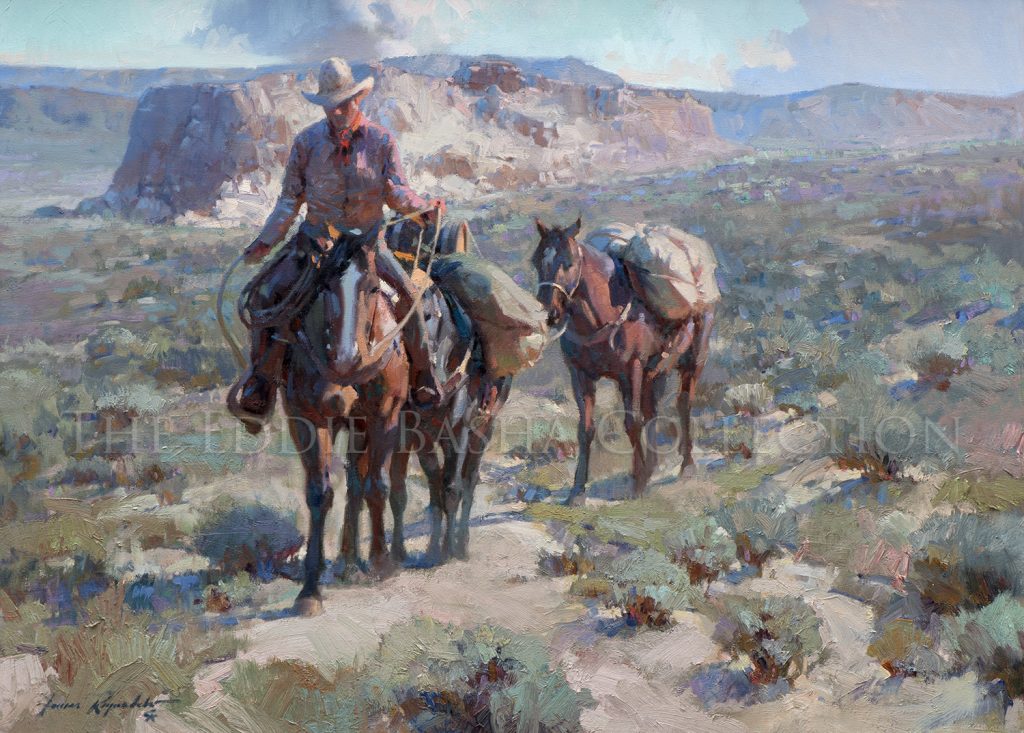 Oil (1994) | Image Size: 26”h x 36”w; Framed Size: 36”h x 45 ½”w
Oil (1994) | Image Size: 26”h x 36”w; Framed Size: 36”h x 45 ½”wJames Reynolds often said that he simply liked to paint cowboys; he found them symbolic of a way of life that he admired. He often placed his cowboys against the backdrop of the Arizona landscape he loved, and also often focused on solitary figures such as this cowboy riding through the sagebrush leading his packhorse. Presented with the cowboy mid-journey, a distant butte in the background gives the viewer the sense that a long distance has just been covered with the implication that an equally long distance is still to be traversed. The scene is timeless; it could have been depicted yesterday, the last century, or perhaps what unfurls tomorrow. The cowboy rides at a steady and unhurried pace, covering a ground that is desolate yet beautiful. A self-sufficient figure in an endless landscape; an eloquent summation of Reynold’s feeling about the land and a lifestyle.
Travelin’ Alone
Artist: James Reynolds, CA (1926-2010)
James Reynolds often said that he simply liked to paint cowboys; he found them symbolic of a way of life that he admired. He often placed his cowboys against the backdrop of the Arizona landscape he loved, and also often focused on solitary figures such as this cowboy riding through the sagebrush leading his packhorse. Presented with the cowboy mid-journey, a distant butte in the background gives the viewer the sense that a long distance has just been covered with the implication that an equally long distance is still to be traversed. The scene is timeless; it could have been depicted yesterday, the last century, or perhaps what unfurls tomorrow. The cowboy rides at a steady and unhurried pace, covering a ground that is desolate yet beautiful. A self-sufficient figure in an endless landscape; an eloquent summation of Reynold’s feeling about the land and a lifestyle.
 Oil | Image Size: 22”h x 34”w; Framed Size: 29”h x 41”w
Oil | Image Size: 22”h x 34”w; Framed Size: 29”h x 41”wDramatic lighting creates an evocative and contemplative mood in this oil painting of two cowboys taking a break after a long day in the saddle. The two have dismounted and gaze across a canyon taking in the brilliantly colored rays of the setting sun at day’s end. The majority of this piece is shown in the approach of dusk’s darkness, but James Reynolds has masterfully lit both men as well as some overhead clouds with the fading sunlight, now grown pink and orange. While this duo has obviously put in a full day’s work, they are still able to enjoy the peace and serenity accorded them by a beautiful scenic vista. And though much of western art portrays the action, drama, and perils of ranching, this piece offers a counterpoint to those subjects. Here, nature is the primary subject and the appreciation of her beauty is the story that Reynolds encapsulated. His talent as a colorist, his sensitivity toward nature’s grandeur, as well as his ability to create a mood are readily conveyed to observers prompting them to gaze across the wide expanse of a panoramic landscape under an extraordinary sky with the two cowboys.
Eddie Basha acquired this piece from the estate of the late Senator Barry Goldwater. The two shared a deep love and passion for Arizona, its people and art. Shortly before the Senator’s passing, the pair enjoyed a final visit with one another as they toured the gallery. They spoke of their mutual affinities as well as their memories of attending the annual Cowboy Artists of America Annual Show & Sale. At one point, Senator Goldwater asked Eddie “Can a guy just come and look at all this art anytime?” With quiet tears streaming down, Eddie responded, “Yes, Senator, anytime you want.” And a similar bittersweet moment was had just a few days prior to Eddie’s passing (March 26, 2013) when he last viewed the collection. It was as if he was seeing it for the very first time and he was genuinely overwhelmed by the extraordinary talents of the artists’ masterworks assembled. The emotionally-filled moment was evident as the quiet tears streamed once again.
Day’s End
Artist: James Reynolds, CA (1926-2010)
Dramatic lighting creates an evocative and contemplative mood in this oil painting of two cowboys taking a break after a long day in the saddle. The two have dismounted and gaze across a canyon taking in the brilliantly colored rays of the setting sun at day’s end. The majority of this piece is shown in the approach of dusk’s darkness, but James Reynolds has masterfully lit both men as well as some overhead clouds with the fading sunlight, now grown pink and orange. While this duo has obviously put in a full day’s work, they are still able to enjoy the peace and serenity accorded them by a beautiful scenic vista. And though much of western art portrays the action, drama, and perils of ranching, this piece offers a counterpoint to those subjects. Here, nature is the primary subject and the appreciation of her beauty is the story that Reynolds encapsulated. His talent as a colorist, his sensitivity toward nature’s grandeur, as well as his ability to create a mood are readily conveyed to observers prompting them to gaze across the wide expanse of a panoramic landscape under an extraordinary sky with the two cowboys.
Eddie Basha acquired this piece from the estate of the late Senator Barry Goldwater. The two shared a deep love and passion for Arizona, its people and art. Shortly before the Senator’s passing, the pair enjoyed a final visit with one another as they toured the gallery. They spoke of their mutual affinities as well as their memories of attending the annual Cowboy Artists of America Annual Show & Sale. At one point, Senator Goldwater asked Eddie “Can a guy just come and look at all this art anytime?” With quiet tears streaming down, Eddie responded, “Yes, Senator, anytime you want.” And a similar bittersweet moment was had just a few days prior to Eddie’s passing (March 26, 2013) when he last viewed the collection. It was as if he was seeing it for the very first time and he was genuinely overwhelmed by the extraordinary talents of the artists’ masterworks assembled. The emotionally-filled moment was evident as the quiet tears streamed once again.
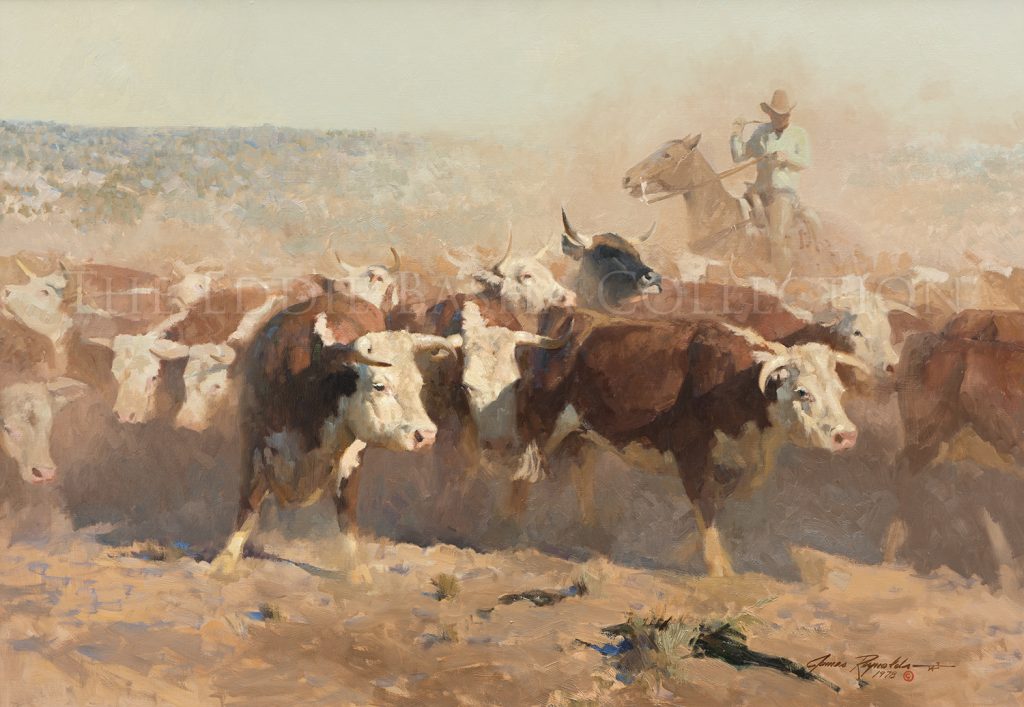 Oil (1978) | Image Size: 28”h x 40”w; Framed Size: 38 ½” h x 50 ½” w
Oil (1978) | Image Size: 28”h x 40”w; Framed Size: 38 ½” h x 50 ½” wFree-ranging cattle are never easy to pen during the seasonal round up. Handling cattle from horseback is the true source of cowboy pride, and it is the work which will always define who the cowboy really is. And because it is hard and dangerous work, a cowboy must be alert, agile, in complete command of his horse, and aware of his surroundings. In this painting of a cowboy working a herd of cattle on an open range, James Reynolds puts us in the midst of the action. The wrangler is turning the herd directly toward the viewer giving the effect of being just a step ahead of the cows as they move forward in billowing clouds of dust. The sunlight of the day is obscured by the dust in the background, but the white faces of the cattle are shown in sharp contrast to the background colors and features which blend together. By placing the cowboy in the right background moving toward the left and showing the cattle moving forward and to the right, Reynolds creates a circle of action and movement. He keeps our eyes focused on that movement by placing the cows with the whitest and brightest faces in the center of the circle.
“Gate Shy” made its first appearance at the 13th Annual Cowboy Artists of America Show & Sale in 1978. Reynolds also won the Colt Award that year selected by his fellow CAA artists in recognition of his body of work.
Gate Shy
Artist: James Reynolds, CA (1926-2010)
Free-ranging cattle are never easy to pen during the seasonal round up. Handling cattle from horseback is the true source of cowboy pride, and it is the work which will always define who the cowboy really is. And because it is hard and dangerous work, a cowboy must be alert, agile, in complete command of his horse, and aware of his surroundings. In this painting of a cowboy working a herd of cattle on an open range, James Reynolds puts us in the midst of the action. The wrangler is turning the herd directly toward the viewer giving the effect of being just a step ahead of the cows as they move forward in billowing clouds of dust. The sunlight of the day is obscured by the dust in the background, but the white faces of the cattle are shown in sharp contrast to the background colors and features which blend together. By placing the cowboy in the right background moving toward the left and showing the cattle moving forward and to the right, Reynolds creates a circle of action and movement. He keeps our eyes focused on that movement by placing the cows with the whitest and brightest faces in the center of the circle.
“Gate Shy” made its first appearance at the 13th Annual Cowboy Artists of America Show & Sale in 1978. Reynolds also won the Colt Award that year selected by his fellow CAA artists in recognition of his body of work.
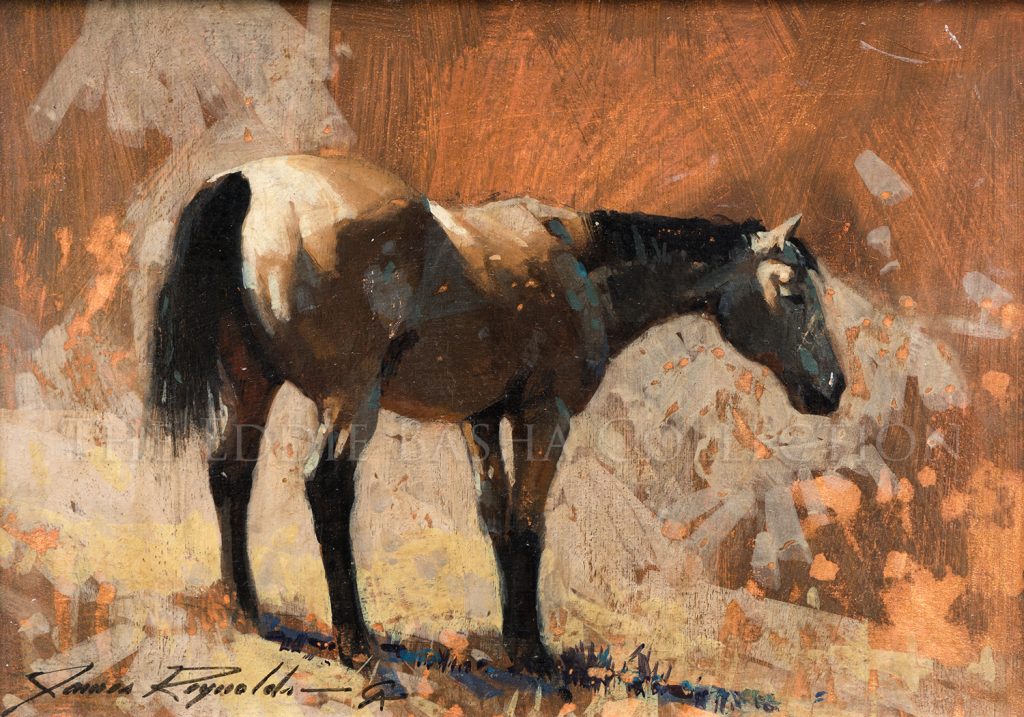 Oil | Image Size: 10”h x 14”w; Framed Size: 17”h x 21”w
Oil | Image Size: 10”h x 14”w; Framed Size: 17”h x 21”wJames Reynolds was a versatile artist who excelled at all aspects of his craft. He was equally adept with landscapes, figure studies, still life images, and action scenes. Even in a small study such as this one of a standing horse, those skills are on full display. The anatomy of the horse is perfect, the contrasting use of lights and darks, shadows and sunlight, highlight the contours of the animal. The background both complements the horse, but also serves as a color contrast to heighten the viewer’s focus on the horse. It is a realistic study, but one that fully reflects the individual style and skill of the artist.
Horse Study
Artist: James Reynolds, CA (1926-2010)
James Reynolds was a versatile artist who excelled at all aspects of his craft. He was equally adept with landscapes, figure studies, still life images, and action scenes. Even in a small study such as this one of a standing horse, those skills are on full display. The anatomy of the horse is perfect, the contrasting use of lights and darks, shadows and sunlight, highlight the contours of the animal. The background both complements the horse, but also serves as a color contrast to heighten the viewer’s focus on the horse. It is a realistic study, but one that fully reflects the individual style and skill of the artist.
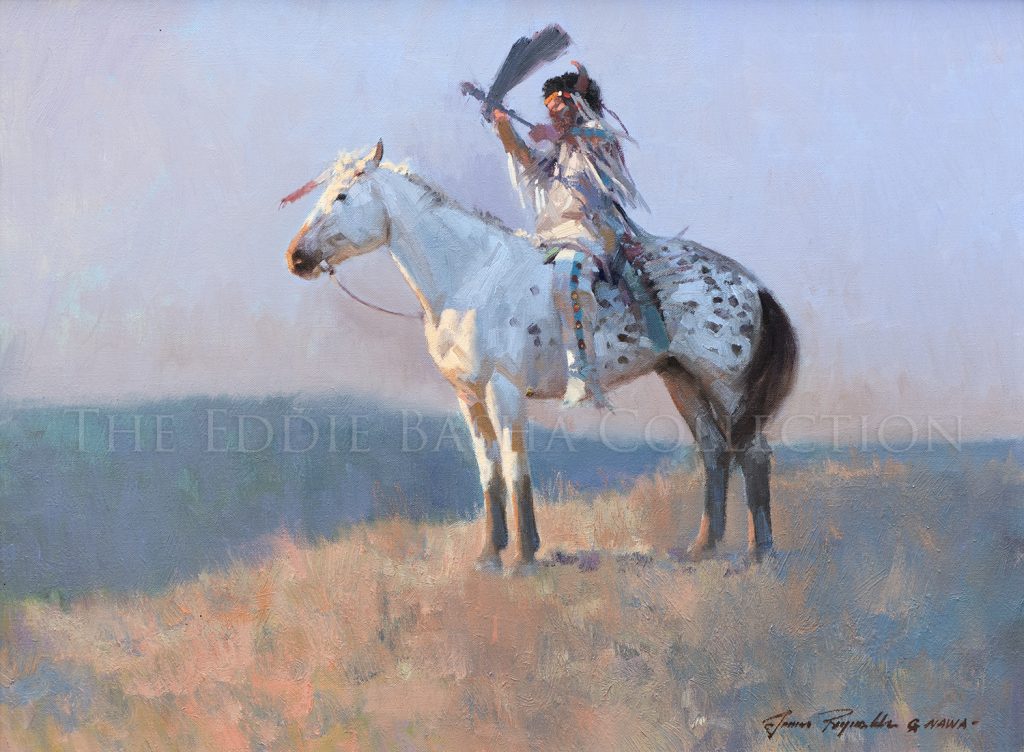 Oil Painting | Image Size: 18”h x 24”w; Framed Size: 26 ¼”h X 32 ¼”w
Oil Painting | Image Size: 18”h x 24”w; Framed Size: 26 ¼”h X 32 ¼”wHere a lone Plains Indian facing east with the morning sun reflecting off his buckskins and the coat of his white horse, he is offering a prayer on behalf of his entire tribe to start the day. He is holding what appears to be a bird fetish and eagle feather and is wearing a buffalo horn headdress suggesting he is a medicine man. Reynolds presents a simple scene with a quiet tone, but one that succinctly reflects the traditions of the Plains culture.
Morning Prayer
Artist: James Reynolds, CA (1926-2010)
Here a lone Plains Indian facing east with the morning sun reflecting off his buckskins and the coat of his white horse, he is offering a prayer on behalf of his entire tribe to start the day. He is holding what appears to be a bird fetish and eagle feather and is wearing a buffalo horn headdress suggesting he is a medicine man. Reynolds presents a simple scene with a quiet tone, but one that succinctly reflects the traditions of the Plains culture.
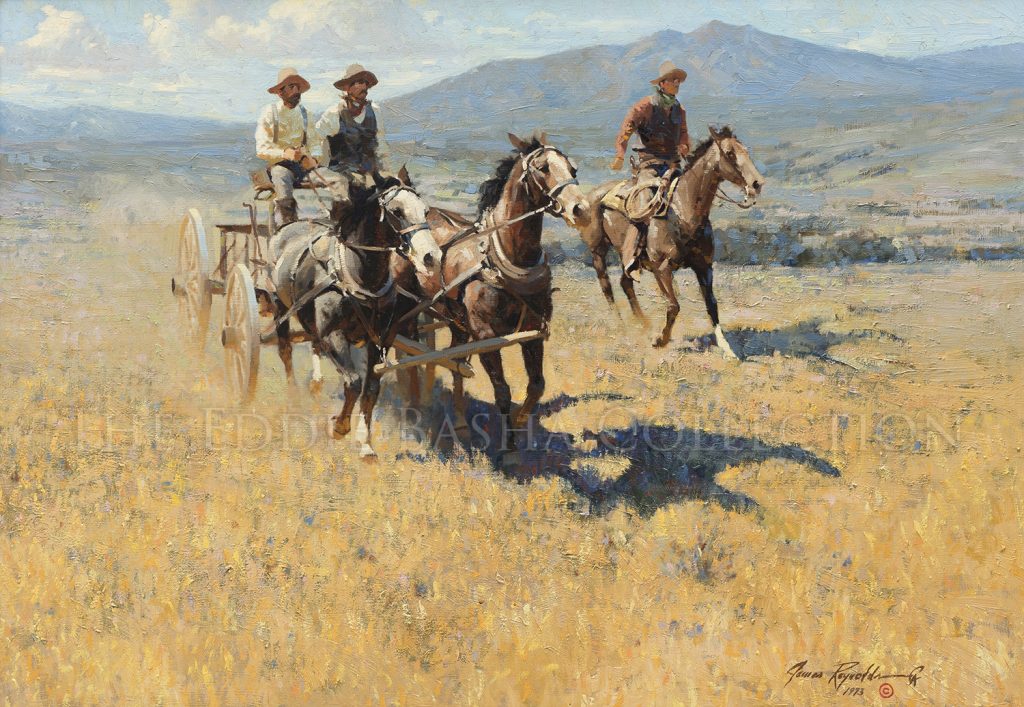 Oil (1973) | Image Size: 28”h x 40”w; Framed Size: 38 ½”h x 50 3/8”w
Oil (1973) | Image Size: 28”h x 40”w; Framed Size: 38 ½”h x 50 3/8”wReynolds uses a muted palette with shades of browns, yellows, and golds to depict a parched landscape that emphasizes the precarious nature of ranch and cattle work. He pictures three cowboys, two in a wagon, and one on horseback who are headed to a cow outfit with much needed supplies. The scene has a universal quality and could easily be set in the 1890’s or the 1980’s. For Reynolds, this slice of ranch life is a glimpse into both the past and present.
Following its 1973 debut at the 8th Annual CAA Exhibition & Sale held at the Phoenix Art Museum, “Supply Wagon” was later exhibited at the “Rendezvous 1993 Exhibition” at The Gilcrease Museum in Tulsa, Oklahoma and today remains a permanent part of The Eddie Basha Collection.
The Supply Wagon
Artist: James Reynolds, CA (1926-2010)
Reynolds uses a muted palette with shades of browns, yellows, and golds to depict a parched landscape that emphasizes the precarious nature of ranch and cattle work. He pictures three cowboys, two in a wagon, and one on horseback who are headed to a cow outfit with much needed supplies. The scene has a universal quality and could easily be set in the 1890’s or the 1980’s. For Reynolds, this slice of ranch life is a glimpse into both the past and present.
Following its 1973 debut at the 8th Annual CAA Exhibition & Sale held at the Phoenix Art Museum, “Supply Wagon” was later exhibited at the “Rendezvous 1993 Exhibition” at The Gilcrease Museum in Tulsa, Oklahoma and today remains a permanent part of The Eddie Basha Collection.
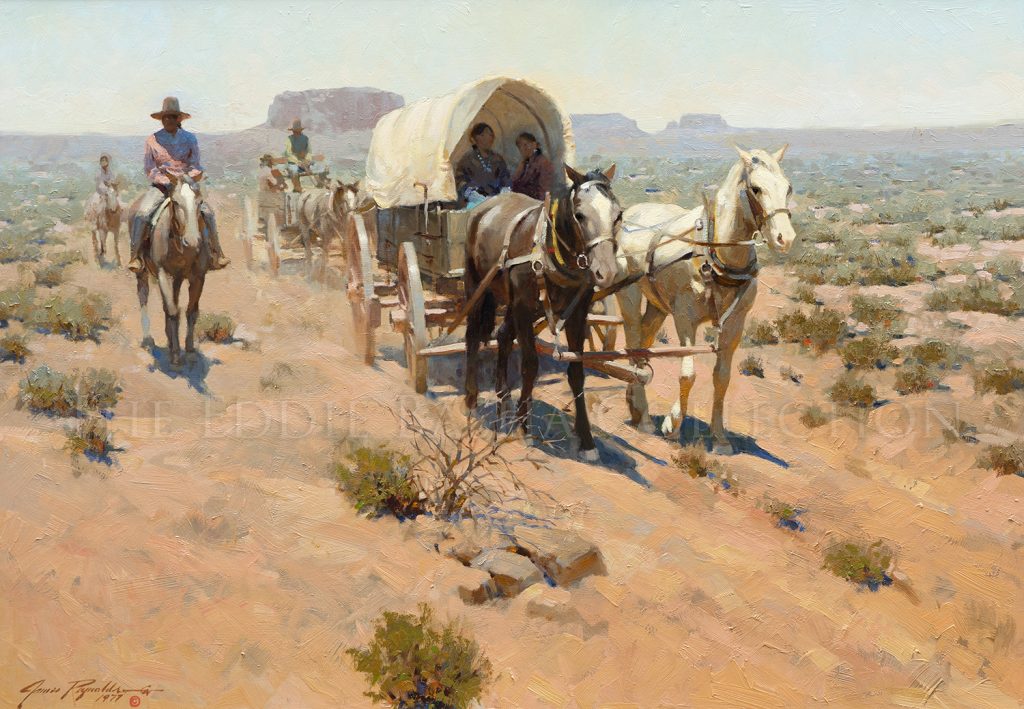 Oil (1977) | Image Size: 28”h x 40”w; Framed Size: 39”h x 50”w
Oil (1977) | Image Size: 28”h x 40”w; Framed Size: 39”h x 50”wIn “The Long Way Home” James Reynolds uses his composition to give the illusion of a vast open space. By placing the largest element in the painting, a horse drawn wagon, in the upper foreground and then arranging various figures in descending sizes behind the wagon, he pulls the viewer’s eye to the distant mesas on the far horizon. The effect gives a sense of just how much territory the wagon and riders have crossed. By using myriad colors to depict the landscape, he also effectively gives a feel for the desert locations.
A master colorist and born storyteller, Reynolds is often cited by other artists as someone who consistently combines all the elements of composition, color, and atmosphere into truly masterful paintings. Reynolds is adept at painting cowboys working a herd of cattle as he is at capturing the beauty of an Arizona sunset. One of his fellow artists has said, “Any painter who wants to learn how to really nail a picture of the west, whether it is the Old West or a scene right out of yesterday, would do well to take a hard look at James Reynold’s work. He gets all of the ingredients right and he does it with a style that is his alone.”
The Long Way Home
Artist: James Reynolds, CA (1926-2010)
In “The Long Way Home” James Reynolds uses his composition to give the illusion of a vast open space. By placing the largest element in the painting, a horse drawn wagon, in the upper foreground and then arranging various figures in descending sizes behind the wagon, he pulls the viewer’s eye to the distant mesas on the far horizon. The effect gives a sense of just how much territory the wagon and riders have crossed. By using myriad colors to depict the landscape, he also effectively gives a feel for the desert locations.
A master colorist and born storyteller, Reynolds is often cited by other artists as someone who consistently combines all the elements of composition, color, and atmosphere into truly masterful paintings. Reynolds is adept at painting cowboys working a herd of cattle as he is at capturing the beauty of an Arizona sunset. One of his fellow artists has said, “Any painter who wants to learn how to really nail a picture of the west, whether it is the Old West or a scene right out of yesterday, would do well to take a hard look at James Reynold’s work. He gets all of the ingredients right and he does it with a style that is his alone.”
 Oil | Image Size: 20”h x 30”w; Framed Size: 29 ¼”h x 39 ¼”w
Oil | Image Size: 20”h x 30”w; Framed Size: 29 ¼”h x 39 ¼”wReynolds achieves a somber, yet sympathetic mood in this painting of a cowhand visiting the grave of a fallen friend by placing the horse and the dismounted rider in a snowy field with only a solitary cross marking the friend’s grave. The horses head is bowed and the cowhand’s hat has been removed which further adds to the tone. Dense gray clouds roiling overhead just above the setting sun keep the whole scene anchored.
An Old Friend
Artist: James Reynolds, CA (1926-2010)
Reynolds achieves a somber, yet sympathetic mood in this painting of a cowhand visiting the grave of a fallen friend by placing the horse and the dismounted rider in a snowy field with only a solitary cross marking the friend’s grave. The horses head is bowed and the cowhand’s hat has been removed which further adds to the tone. Dense gray clouds roiling overhead just above the setting sun keep the whole scene anchored.
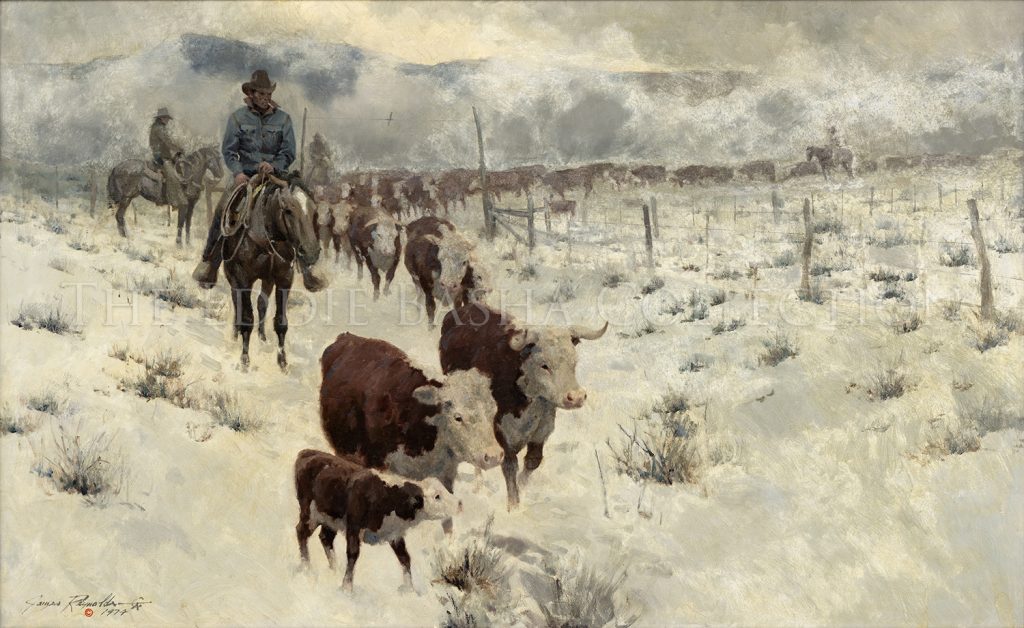 Oil (1974) | Image Size: 30”h x 48”w; Framed Size: 40 ½”h x 58 ½”w
Oil (1974) | Image Size: 30”h x 48”w; Framed Size: 40 ½”h x 58 ½”wThis large painting of a long trail of cattle being led by a small group of cowboys across the frozen, snow- covered ground truly evokes the bitter cold and harsh reality of working cattle in winter. It is a splendid example of Reynolds’ ability to create a specific mood and to depict a particular seasonal landscape. The painting is masterfully composed: As the viewer’s eye is guided from the upper right of the canvas where the line of cattle begins, the moving herd forms a semi-circle ending front and center with the depiction of the lead cowboy and three cows, one of which is a calf, giving an illusion of great space and the steady pace of the men and herd. And even though Reynolds uses impressionistic techniques in terms of brushstrokes and detail, the snowy landscape, the wisps of white clouds obscuring the background, and the cowboys in their winter garb paint a realistic setting for the action at hand. His purpose is not to present a photo realistic depiction of working a herd during the winter, but to evoke the feeling of that work and what that life would be like. Even the small details such as the cigarette dangling from the lead cowboy’s mouth adds to the authenticity of the scene.
“The Last Gate” won the Silver Medal in oil painting and the auspicious George Phippen Award, the most popular work in the show, at the 9th Annual Cowboy Artists of America Show & Sale in 1974 at the Phoenix Art Museum.
The Last Gate
Artist: James Reynolds, CA (1926-2010)
This large painting of a long trail of cattle being led by a small group of cowboys across the frozen, snow- covered ground truly evokes the bitter cold and harsh reality of working cattle in winter. It is a splendid example of Reynolds’ ability to create a specific mood and to depict a particular seasonal landscape. The painting is masterfully composed: As the viewer’s eye is guided from the upper right of the canvas where the line of cattle begins, the moving herd forms a semi-circle ending front and center with the depiction of the lead cowboy and three cows, one of which is a calf, giving an illusion of great space and the steady pace of the men and herd. And even though Reynolds uses impressionistic techniques in terms of brushstrokes and detail, the snowy landscape, the wisps of white clouds obscuring the background, and the cowboys in their winter garb paint a realistic setting for the action at hand. His purpose is not to present a photo realistic depiction of working a herd during the winter, but to evoke the feeling of that work and what that life would be like. Even the small details such as the cigarette dangling from the lead cowboy’s mouth adds to the authenticity of the scene.
“The Last Gate” won the Silver Medal in oil painting and the auspicious George Phippen Award, the most popular work in the show, at the 9th Annual Cowboy Artists of America Show & Sale in 1974 at the Phoenix Art Museum.
 Oil (1985) | Image Size: 24”h x 36”w; Framed Size: 34 ½”h x 46 ½”w
Oil (1985) | Image Size: 24”h x 36”w; Framed Size: 34 ½”h x 46 ½”wJames Reynolds was adept at adding seemingly small details or effects that could greatly enhance the overall success of a painting. Here as a wrangler is working a small herd of cattle, a reddish brown cloud of dust is just beginning to obscure the figures of the cowboy and cows; the cowboy and cows are moving away from the viewer except for one small calf with a bright white face that has turned in the opposite direction. By painting that calf’s face in bright sunlight unobscured by the rising dust cloud, Reynolds focuses our attention on the center of the painting and the center of the action. The artist captured all of the various elements of this scene from the milling action of the cows, the impressionistic handling of the landscape, and the masterful use of color and light to emphasize the inherent drama of the action.
A Long Day Ahead
Artist: James Reynolds, CA (1926-2010)
James Reynolds was adept at adding seemingly small details or effects that could greatly enhance the overall success of a painting. Here as a wrangler is working a small herd of cattle, a reddish brown cloud of dust is just beginning to obscure the figures of the cowboy and cows; the cowboy and cows are moving away from the viewer except for one small calf with a bright white face that has turned in the opposite direction. By painting that calf’s face in bright sunlight unobscured by the rising dust cloud, Reynolds focuses our attention on the center of the painting and the center of the action. The artist captured all of the various elements of this scene from the milling action of the cows, the impressionistic handling of the landscape, and the masterful use of color and light to emphasize the inherent drama of the action.
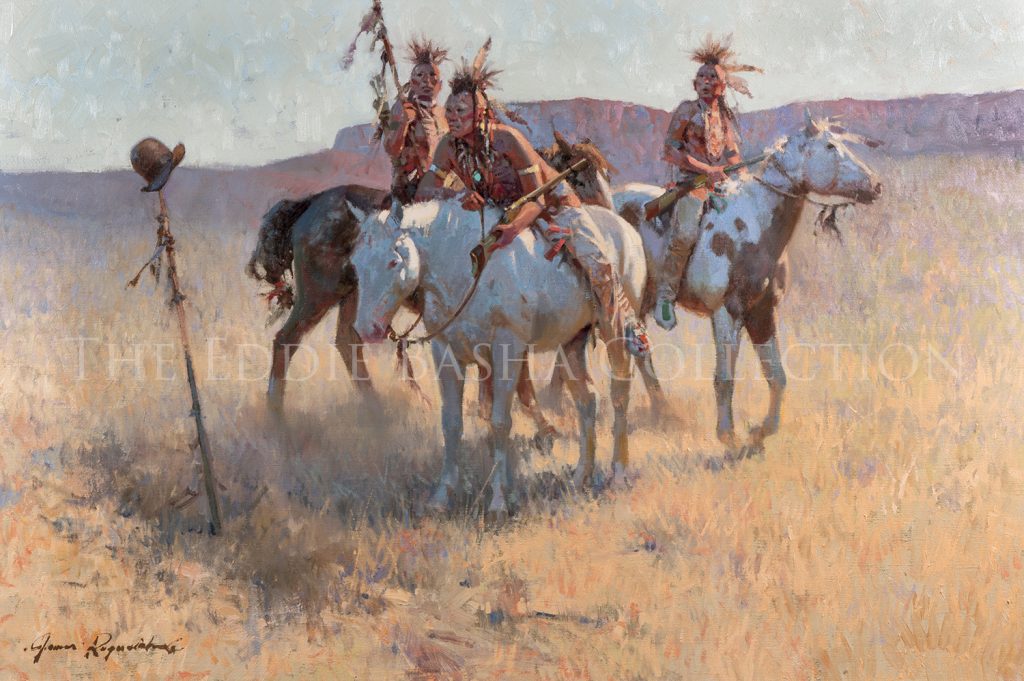 Oil | Image Size: 26”h x 36”w; Framed Size: 36”h x 48”w
Oil | Image Size: 26”h x 36”w; Framed Size: 36”h x 48”wReynolds did not flinch from portraying difficult subjects that were true to the history of the periods he depicted. This masterwork oil painting shows three Indians coming upon a warrior’s lance stuck in the ground with an unlucky soul’s hat atop, an indication that death was done here, without witness, in the silence of the sage. The rather bleak subject matter is emphasized by the parched and barren landscape captured in a muted palette, but one that employed many colors in subtle shadings. The figures of the horses and Indians are exceptionally well-drawn.
A Strange Sign
Artist: James Reynolds, CA (1926-2010)
Reynolds did not flinch from portraying difficult subjects that were true to the history of the periods he depicted. This masterwork oil painting shows three Indians coming upon a warrior’s lance stuck in the ground with an unlucky soul’s hat atop, an indication that death was done here, without witness, in the silence of the sage. The rather bleak subject matter is emphasized by the parched and barren landscape captured in a muted palette, but one that employed many colors in subtle shadings. The figures of the horses and Indians are exceptionally well-drawn.
 Oil | Image Size: 36”h x 48”w; Framed Size: 47”h x 59”w
Oil | Image Size: 36”h x 48”w; Framed Size: 47”h x 59”wFirearms were superior in battle to the warrior’s traditional hand lance. A prized rifle might be captured from a fallen foe or obtained in a trade for horses. These traders are a horse apart from making a deal.
As one of James Reynolds’ major paintings … it is large, tells a compelling story, and illustrates his skill as a landscape painter who can master lighting and color as well as his talent for realistically depicting figures in an impressionistic style. Here a group of Plains Indians are examining a rifle that an Indian from a distant tribe has brought to trade. The group is arranged in a triangle with the trader at the point while a group of mounted Indians and a pony form the top side. The group is shown on a vast prairie with brilliant pink clouds, a Reynolds’ hallmark, in the center background. The pink light seems to wash over the entire background, while the foreground containing the figures is painted in cooler tones. We see the participants mid negotiation; the trader is pointing out the finer details of the rifle while his potential customers look on in rapt attention. Such a scene was most likely played out on these plains hundreds of times and Reynolds has perfectly captured the nuances of the potential deal and given the viewer a great sense of time and place. In this painting, Reynolds very effectively combines his talents as both a painter and storyteller.
Private collections, museums and galleries abound with James Reynolds work as well as the work of numerous other artists of the Western American genre. To find a museum in your area, visit www.museumswest.org for a complete listing!
Thunder Stick
Artist: James Reynolds, CA (1926-2010)
Firearms were superior in battle to the warrior’s traditional hand lance. A prized rifle might be captured from a fallen foe or obtained in a trade for horses. These traders are a horse apart from making a deal.
As one of James Reynolds’ major paintings … it is large, tells a compelling story, and illustrates his skill as a landscape painter who can master lighting and color as well as his talent for realistically depicting figures in an impressionistic style. Here a group of Plains Indians are examining a rifle that an Indian from a distant tribe has brought to trade. The group is arranged in a triangle with the trader at the point while a group of mounted Indians and a pony form the top side. The group is shown on a vast prairie with brilliant pink clouds, a Reynolds’ hallmark, in the center background. The pink light seems to wash over the entire background, while the foreground containing the figures is painted in cooler tones. We see the participants mid negotiation; the trader is pointing out the finer details of the rifle while his potential customers look on in rapt attention. Such a scene was most likely played out on these plains hundreds of times and Reynolds has perfectly captured the nuances of the potential deal and given the viewer a great sense of time and place. In this painting, Reynolds very effectively combines his talents as both a painter and storyteller.
Private collections, museums and galleries abound with James Reynolds work as well as the work of numerous other artists of the Western American genre. To find a museum in your area, visit www.museumswest.org for a complete listing!
 Oil (1991) | Image Size: 28”h x 48”w; Framed Size: 38”h x 58”w
Oil (1991) | Image Size: 28”h x 48”w; Framed Size: 38”h x 58”wIn this painting, Reynolds has depicted prairie warriors examining the wheel ruts left by the passing wagon trains of Anglo immigrants. Their faces reflect concern and foreshadow the despair and tragedy for those who follow the buffalo and their way of life on the plains.
“Unwelcome Tracks” is a very good example of Reynolds’ mature style and is consistent with his known subject matter, palette, draftsmanship, execution, and sense of strongly narrative compositions. He has utilized a triangular grouping of figures and horses in the center of the canvas that serves to continuously redirect the viewers’ focus to the figures anchored in the landscape.
Unwelcome Tracks
Artist: James Reynolds, CA (1926-2010)
In this painting, Reynolds has depicted prairie warriors examining the wheel ruts left by the passing wagon trains of Anglo immigrants. Their faces reflect concern and foreshadow the despair and tragedy for those who follow the buffalo and their way of life on the plains.
“Unwelcome Tracks” is a very good example of Reynolds’ mature style and is consistent with his known subject matter, palette, draftsmanship, execution, and sense of strongly narrative compositions. He has utilized a triangular grouping of figures and horses in the center of the canvas that serves to continuously redirect the viewers’ focus to the figures anchored in the landscape.
 Oil (1981) | Image Size: 28”h x 40”w; 38 ½"h x 50 ½"w
Oil (1981) | Image Size: 28”h x 40”w; 38 ½"h x 50 ½"wWorking cattle can be a difficult and often dangerous business. It requires skill as a horseman, dexterity as a roper, and a thorough knowledge of animals that change direction and speed in a matter of seconds. “Winter Pasture” is an effective oil painting of the mechanics and potential drama inherent in this work.
Under a looming dark sky, Reynolds presents a cowboy working his herd and moving them into winter pasture. The cows occupy the middle ground of the painting and fill up the canvas presenting the viewer with a glimpse of the difficult tasks cowboys face such as commanding a herd of animals that may be spooked by an approaching storm or may stubbornly refuse to move. And since the cows are moving in and out of the scene, there is the sense that the cowboy is managing a far larger herd than is depicted. While the action of the painting is not frenetic, we do get an impression of constant motion, of being in the middle of a situation that could turn dicey.
Winter Pasture
Artist: James Reynolds, CA (1926-2010)
Working cattle can be a difficult and often dangerous business. It requires skill as a horseman, dexterity as a roper, and a thorough knowledge of animals that change direction and speed in a matter of seconds. “Winter Pasture” is an effective oil painting of the mechanics and potential drama inherent in this work.
Under a looming dark sky, Reynolds presents a cowboy working his herd and moving them into winter pasture. The cows occupy the middle ground of the painting and fill up the canvas presenting the viewer with a glimpse of the difficult tasks cowboys face such as commanding a herd of animals that may be spooked by an approaching storm or may stubbornly refuse to move. And since the cows are moving in and out of the scene, there is the sense that the cowboy is managing a far larger herd than is depicted. While the action of the painting is not frenetic, we do get an impression of constant motion, of being in the middle of a situation that could turn dicey.
 Oil (1985) | Image Size: 28”h x 40”w; Framed Size: 37”h x 49"w
Oil (1985) | Image Size: 28”h x 40”w; Framed Size: 37”h x 49"wArtists often say that one of their intentions in producing a painting is to give the viewer a sense of being there, to make them feel the scene as well as see it. This painting of a small cow outfit heading out on a cold morning achieves that goal. The cowboys, horses, and wagon are bathed in the pink glow of the rising sun; the chill of the air is communicated by the snow-covered ground and the glow of the cookfire warming the coffee. Reynolds set just the right tone for his story to unfold in the viewer’s imagination.
“Cold Country, Hot Coffee” made its debut at the 20th Annual Cowboy Artists of America Exhibition & Sale in 1985 at the Phoenix Art Museum. Subsequently, it was loaned to The Thomas Gilcrease Institute of American History & Art (Tulsa, OK) for the Rendezvous 1993 Exhibition.
Cold Country, Hot Coffee
Artist: James Reynolds, CA (1926-2010)
Artists often say that one of their intentions in producing a painting is to give the viewer a sense of being there, to make them feel the scene as well as see it. This painting of a small cow outfit heading out on a cold morning achieves that goal. The cowboys, horses, and wagon are bathed in the pink glow of the rising sun; the chill of the air is communicated by the snow-covered ground and the glow of the cookfire warming the coffee. Reynolds set just the right tone for his story to unfold in the viewer’s imagination.
“Cold Country, Hot Coffee” made its debut at the 20th Annual Cowboy Artists of America Exhibition & Sale in 1985 at the Phoenix Art Museum. Subsequently, it was loaned to The Thomas Gilcrease Institute of American History & Art (Tulsa, OK) for the Rendezvous 1993 Exhibition.
 Oil | Image Size: 30”h x 48”w; Framed Size: 44.5”h x 62”w
Oil | Image Size: 30”h x 48”w; Framed Size: 44.5”h x 62”wIt is evident from much of James Reynolds’ work that he had a strong connection to the American Southwest—it’s history, landscape, and people. All of those elements are on display in this painting of a group of mounted Chiricahua Apaches shown in bright sunlight against the rugged high desert landscape of their native land. The Apache and their horses are painted in vivid colors with authentic late nineteenth century details of dress and weaponry. The harsh, yet beautiful environment is depicted with a true impression of the arid climate. Reynolds has placed his subjects on a downward slope in the center of the painting poised in the shade cast by a large boulder behind them. He effectively contrasts the coolness of the shadow with the heat and brightness of the surrounding desert. In this painting, Reynolds’ talent as a landscapist and figure painter are on equal display.
Chiricahua Stronghold
Artist: James Reynolds, CA (1926-2010)
It is evident from much of James Reynolds’ work that he had a strong connection to the American Southwest—it’s history, landscape, and people. All of those elements are on display in this painting of a group of mounted Chiricahua Apaches shown in bright sunlight against the rugged high desert landscape of their native land. The Apache and their horses are painted in vivid colors with authentic late nineteenth century details of dress and weaponry. The harsh, yet beautiful environment is depicted with a true impression of the arid climate. Reynolds has placed his subjects on a downward slope in the center of the painting poised in the shade cast by a large boulder behind them. He effectively contrasts the coolness of the shadow with the heat and brightness of the surrounding desert. In this painting, Reynolds’ talent as a landscapist and figure painter are on equal display.
 Oil on Board (1979) | Image Size: 18”h x 24”w; Framed Size: 28”h x 34”w
Oil on Board (1979) | Image Size: 18”h x 24”w; Framed Size: 28”h x 34”wOnce again, James Reynolds demonstrated his mastery at conveying a mood through a vivid depiction of a winter landscape. However, in this painting of a mare and her colt, the mood is not somber or desolate. The ground is covered with snow, but the horses are standing in a patch of bright sunlight and the mother’s protective stance appears to be shielding her colt from the coming chill of the night. There is definite affection between the two.
Mare and Colt
Artist: James Reynolds, CA (1926-2010)
Once again, James Reynolds demonstrated his mastery at conveying a mood through a vivid depiction of a winter landscape. However, in this painting of a mare and her colt, the mood is not somber or desolate. The ground is covered with snow, but the horses are standing in a patch of bright sunlight and the mother’s protective stance appears to be shielding her colt from the coming chill of the night. There is definite affection between the two.
 Oil (1973) | Image Size: 28”h x 40”w
Oil (1973) | Image Size: 28”h x 40”wJames Reynolds used a simple, but very effective, compositional device to focus the viewer’s attention on the heart of this painting, a triangle. The point of the triangle is formed by the wagon and team of horses and the sides are formed by the gully, which leads from the wagon to the foreground, and the wagon and two riders who are moving toward the upper right of the canvas. The cowboys’ yellow slickers also serve to keep our attention on the action at hand. As always, Reynolds set the action of the painting against a compelling landscape that created a palpable atmosphere, placing the viewer in a specific time and place, and exacting a genuine feel of working in inclement weather to get a difficult job done.
“A Helpin’ Hand” made its debut at the 8th Annual Cowboy Artists of America Exhibition & Sale held at the Phoenix Art Museum in 1973.
A Helpin’ Hand
Artist: James Reynolds, CA (1926-2010)
James Reynolds used a simple, but very effective, compositional device to focus the viewer’s attention on the heart of this painting, a triangle. The point of the triangle is formed by the wagon and team of horses and the sides are formed by the gully, which leads from the wagon to the foreground, and the wagon and two riders who are moving toward the upper right of the canvas. The cowboys’ yellow slickers also serve to keep our attention on the action at hand. As always, Reynolds set the action of the painting against a compelling landscape that created a palpable atmosphere, placing the viewer in a specific time and place, and exacting a genuine feel of working in inclement weather to get a difficult job done.
“A Helpin’ Hand” made its debut at the 8th Annual Cowboy Artists of America Exhibition & Sale held at the Phoenix Art Museum in 1973.
 Oil (1998) | Image Size: 36”h x 48”w; Framed Size: 46”h x 58”w
Oil (1998) | Image Size: 36”h x 48”w; Framed Size: 46”h x 58”wA long time ago, huge herds of buffalo grazed upon the broad western prairies. It was the very heart of the cultures and traditions of the great plains. The hunt for the great beasts meant survival for the prairie people. Slowly but surely through the efforts of many, the great herds are being reestablished.
James Reynolds captured the drama, excitement, action and even the chaos of a buffalo hunt by a group of mounted Plains Indians who display both their horsemanship and prowess as hunters using bows and arrows. Reynolds has created a scene of intense action and movement, but he has also been careful to include authentic details of the period, such as the handprint on the leading Indian’s white horse, a sign that this individual has touched an opponent in battle. The action is set against a parched and rolling prairie landscape underneath a cloud filled blue sky. While the dust cloud from the riders and herd obscures the trailing Indians and animals, the leading players are shown in clear detail.
Like many of his predecessor artists, most notably Charles M. Russell, Reynolds found in the buffalo hunt a subject that has universal appeal illuminating both the bravery and skill of the hunters and the magnificence of the hunted.
This piece was first exhibited at the Prix de West Invitational held at the National Cowboy & Western Heritage Museum in Oklahoma City, OK, and subsequently found its home in The Eddie Basha Collection. In 2022, it was loaned to the Briscoe Western Art Museum in San Antonio, TX, for the “Sons of Charlie Russell: Cowboy Artists of America” exhibition. And, once the expansion area of Western Spirit: Scottsdale Museum of the West is complete, “The Hunt” will be exhibited in its new surroundings.
The Hunt
Artist: James Reynolds, CA (1926-2010)
A long time ago, huge herds of buffalo grazed upon the broad western prairies. It was the very heart of the cultures and traditions of the great plains. The hunt for the great beasts meant survival for the prairie people. Slowly but surely through the efforts of many, the great herds are being reestablished.
James Reynolds captured the drama, excitement, action and even the chaos of a buffalo hunt by a group of mounted Plains Indians who display both their horsemanship and prowess as hunters using bows and arrows. Reynolds has created a scene of intense action and movement, but he has also been careful to include authentic details of the period, such as the handprint on the leading Indian’s white horse, a sign that this individual has touched an opponent in battle. The action is set against a parched and rolling prairie landscape underneath a cloud filled blue sky. While the dust cloud from the riders and herd obscures the trailing Indians and animals, the leading players are shown in clear detail.
Like many of his predecessor artists, most notably Charles M. Russell, Reynolds found in the buffalo hunt a subject that has universal appeal illuminating both the bravery and skill of the hunters and the magnificence of the hunted.
This piece was first exhibited at the Prix de West Invitational held at the National Cowboy & Western Heritage Museum in Oklahoma City, OK, and subsequently found its home in The Eddie Basha Collection. In 2022, it was loaned to the Briscoe Western Art Museum in San Antonio, TX, for the “Sons of Charlie Russell: Cowboy Artists of America” exhibition. And, once the expansion area of Western Spirit: Scottsdale Museum of the West is complete, “The Hunt” will be exhibited in its new surroundings.
 Oil | Image Size: 12”h x 16”w; Framed Size: 25”h x 29”w
Oil | Image Size: 12”h x 16”w; Framed Size: 25”h x 29”wColor, light, shadow, and texture are all essential elements of a finely done landscape. James Reynolds shows his expertise with all in this vista. The shadows and deep colors of the forested foreground gradually lighten as the viewer’s eye is lured upward by the alluring mountains in the background. Though a small image, it manages to project a sense of grandeur.
The Chiricahua Mountains are a large mountain range in southeastern Arizona; the range is part of the Coronado National Forest. The highest point, Chiricahua Peak, rises 9,759 feet above sea level, approximately 6,000 feet above the surrounding valleys.
Chiricahua Mountains
Artist: James Reynolds, CA (1926-2010)
Color, light, shadow, and texture are all essential elements of a finely done landscape. James Reynolds shows his expertise with all in this vista. The shadows and deep colors of the forested foreground gradually lighten as the viewer’s eye is lured upward by the alluring mountains in the background. Though a small image, it manages to project a sense of grandeur.
The Chiricahua Mountains are a large mountain range in southeastern Arizona; the range is part of the Coronado National Forest. The highest point, Chiricahua Peak, rises 9,759 feet above sea level, approximately 6,000 feet above the surrounding valleys.
 Oil (1991) | Image Size: 16”h x 20”w; Framed Size: 19”h x 23”w
Oil (1991) | Image Size: 16”h x 20”w; Framed Size: 19”h x 23”wThroughout much of James Reynolds’ career, he was known for his narrative paintings about the West, but those paintings also revealed his amazing talent as a landscape painter. Toward the end of his career, much of his time was spent painting the landscapes he was passionate about: deserts, prairies, mountains, lakes and rivers, forests, and seasonal changes upon those terrains. He found solace in the beauty and bounty of nature.
After the Rain
Artist: James Reynolds, CA (1926-2010)
Throughout much of James Reynolds’ career, he was known for his narrative paintings about the West, but those paintings also revealed his amazing talent as a landscape painter. Toward the end of his career, much of his time was spent painting the landscapes he was passionate about: deserts, prairies, mountains, lakes and rivers, forests, and seasonal changes upon those terrains. He found solace in the beauty and bounty of nature.
 Oil (1977) | Image Size: 30”h x 48”w; Framed Size: 40”h x 58”w
Oil (1977) | Image Size: 30”h x 48”w; Framed Size: 40”h x 58”wCommerce in the early west rolled upon iron-rimmed wagon wheels. Lured westward by the promise of profit in far flung outposts of civilization, tough men took up the challenge of danger and distance. And James Reynolds told the story well and provided the narrative elements of the cowboys, the team of six horses and the freighter on their frozen journey, but he also added visual details that contributed to the drama unfolding. The band of gray sky above the snowcapped mountains gives way to the bluish white snow of the terrain providing viewers with a realistic feel for the weather and the atmosphere of the day. The riders make their way toward the sun which casts a glancing light that is reflected off the wagon and the white horse at the center of the wagon team—that subtle addition serves to fix the viewer’s eye on the center of the painting. The entire canvas is covered with cool colors that emphasize the cold and winter weather. All of these visual elements move the story along, but also inspire an emotional response.
The Freighter
Artist: James Reynolds, CA (1926-2010)
Commerce in the early west rolled upon iron-rimmed wagon wheels. Lured westward by the promise of profit in far flung outposts of civilization, tough men took up the challenge of danger and distance. And James Reynolds told the story well and provided the narrative elements of the cowboys, the team of six horses and the freighter on their frozen journey, but he also added visual details that contributed to the drama unfolding. The band of gray sky above the snowcapped mountains gives way to the bluish white snow of the terrain providing viewers with a realistic feel for the weather and the atmosphere of the day. The riders make their way toward the sun which casts a glancing light that is reflected off the wagon and the white horse at the center of the wagon team—that subtle addition serves to fix the viewer’s eye on the center of the painting. The entire canvas is covered with cool colors that emphasize the cold and winter weather. All of these visual elements move the story along, but also inspire an emotional response.
 Oil | Image Size: 18”h x 24”w; Framed Size 26 ¾"h x 32 ¾"w
Oil | Image Size: 18”h x 24”w; Framed Size 26 ¾"h x 32 ¾"w James Reynolds’ artistry as both a figure painter and a landscapist are on full display in “Good Grass”. Naturally, the bison group is painted harmoniously with
the surrounding landscape. The good grass of the painting’s title composes three quarters of the painting while the rest of the canvas is composed of bands of colors in the background; a dark, green line of trees is placed behind the buffalo and is topped
with a bluish mountain chain and a pale blue sky filled with white clouds completing the scene. These disparate colors blend well to form the perfect backdrop for the grazing animals.
Good Grass
Artist: James Reynolds, CA (1926-2010)
James Reynolds’ artistry as both a figure painter and a landscapist are on full display in “Good Grass”. Naturally, the bison group is painted harmoniously with
the surrounding landscape. The good grass of the painting’s title composes three quarters of the painting while the rest of the canvas is composed of bands of colors in the background; a dark, green line of trees is placed behind the buffalo and is topped
with a bluish mountain chain and a pale blue sky filled with white clouds completing the scene. These disparate colors blend well to form the perfect backdrop for the grazing animals.
 Oil (1976) | Image Size: 28”h x 40”w; Framed Size: 39”h x 51”w
Oil (1976) | Image Size: 28”h x 40”w; Framed Size: 39”h x 51”wA stagecoach stopped on a snow covered route under a dark, overcast sky captures the harsh realities of a winter’s aura as well as the extraordinary capacities of both man and mammal that went into moving a stage across difficult terrain. The front wheel position, the coachman’s angled footboard, the slackened reigns, and the well placed horizon speak to not only the authenticity of the era, but are a testament to the artist’s expertise. Lighting, landscapes, and history… James Reynolds was indeed a triple threat.
The Changeover
Artist: James Reynolds, CA (1926-2010)
A stagecoach stopped on a snow covered route under a dark, overcast sky captures the harsh realities of a winter’s aura as well as the extraordinary capacities of both man and mammal that went into moving a stage across difficult terrain. The front wheel position, the coachman’s angled footboard, the slackened reigns, and the well placed horizon speak to not only the authenticity of the era, but are a testament to the artist’s expertise. Lighting, landscapes, and history… James Reynolds was indeed a triple threat.
 Oil (1991) | Image Size: 18”h x 24”w; Framed Size: 28”h x 34”w
Oil (1991) | Image Size: 18”h x 24”w; Framed Size: 28”h x 34”wJames Reynolds was born in a Standard Oil lease house in 1926 and raised in Taft, California. He spent summers at his grandmother’s Nevada City hotel which was situated just beyond the infamous Donner Pass and literally above the south fork of the Yuba River. During those formative years, he heard many stories of the old West and developed a lifelong fascination with western history. Although he dabbled in art during grade school, Reynolds didn’t investigate being an artist seriously until after his service in the World War II Pacific theatre.
He enrolled in the Kann Institute of Art in Beverly Hills, CA, for one year and then attended the School of Allied Arts in Glendale, CA, for four. Following, he found work in Hollywood. For a decade and a half he sketched storyboards and sets for most of the major studios. After a particularly grueling assignment designing and helping to apply a body of tattoos on actor Rod Steiger for the film version of “The Illustrated Man,” which was photographed by Life Magazine, Reynolds moved to Sedona to devote his time painting images of the historic and contemporary West.
Few artists ever receive the honor of becoming known as a “painter’s painter.” Reynolds is one such artist. A master colorist and born storyteller, Reynolds is often cited by other artists as one who consistently combines all the elements of composition, color and atmosphere into masterful paintings. Reynolds is as adept at painting cowboys working a herd of cattle as he is at capturing the beauty of an Arizona sunset. One of his fellow artists said, “Any painter who wants to learn how to really nail a picture of the west, whether it is the Old West or a scene right out of yesterday, would do well to take a hard look at James Reynold’s work. He gets all of the ingredients right and he does it with a style that is his alone.”
Reynolds often said that great art is born of a keen sense of observation. An artist, he said, has to be adept at truly seeing the landscape around him. As is clear from his work, Reynolds was committed to painting the strong vibrant colors of the West, but he was also adamant that those colors match the exact values that are found in nature. Reynolds was so successful in achieving these goals that his work has become a model for contemporary artists.
Reynolds became a member of the Cowboy Artists of America in 1968 and received top honors the same year he left Hollywood. He was the first artist to win the Prix de West Invitational award, the Buyer’s Choice award, and the Gold Medal for painting at the National Academy of Western Art in Oklahoma City.
Almost Home
Artist: James Reynolds, CA (1926-2010)
James Reynolds was born in a Standard Oil lease house in 1926 and raised in Taft, California. He spent summers at his grandmother’s Nevada City hotel which was situated just beyond the infamous Donner Pass and literally above the south fork of the Yuba River. During those formative years, he heard many stories of the old West and developed a lifelong fascination with western history. Although he dabbled in art during grade school, Reynolds didn’t investigate being an artist seriously until after his service in the World War II Pacific theatre.
He enrolled in the Kann Institute of Art in Beverly Hills, CA, for one year and then attended the School of Allied Arts in Glendale, CA, for four. Following, he found work in Hollywood. For a decade and a half he sketched storyboards and sets for most of the major studios. After a particularly grueling assignment designing and helping to apply a body of tattoos on actor Rod Steiger for the film version of “The Illustrated Man,” which was photographed by Life Magazine, Reynolds moved to Sedona to devote his time painting images of the historic and contemporary West.
Few artists ever receive the honor of becoming known as a “painter’s painter.” Reynolds is one such artist. A master colorist and born storyteller, Reynolds is often cited by other artists as one who consistently combines all the elements of composition, color and atmosphere into masterful paintings. Reynolds is as adept at painting cowboys working a herd of cattle as he is at capturing the beauty of an Arizona sunset. One of his fellow artists said, “Any painter who wants to learn how to really nail a picture of the west, whether it is the Old West or a scene right out of yesterday, would do well to take a hard look at James Reynold’s work. He gets all of the ingredients right and he does it with a style that is his alone.”
Reynolds often said that great art is born of a keen sense of observation. An artist, he said, has to be adept at truly seeing the landscape around him. As is clear from his work, Reynolds was committed to painting the strong vibrant colors of the West, but he was also adamant that those colors match the exact values that are found in nature. Reynolds was so successful in achieving these goals that his work has become a model for contemporary artists.
Reynolds became a member of the Cowboy Artists of America in 1968 and received top honors the same year he left Hollywood. He was the first artist to win the Prix de West Invitational award, the Buyer’s Choice award, and the Gold Medal for painting at the National Academy of Western Art in Oklahoma City.
 Oil | Image Size: 20”h x 30”w; Framed Size: 29 ¼”h x 39”w
Oil | Image Size: 20”h x 30”w; Framed Size: 29 ¼”h x 39”wThrough the contours of the snow covered ground, the cowboy leads his Christmas tree laden pack horse toward the cabin and corral in the background. The single window lit from within conveys the warmth and comfort that soon awaits. Reynolds has led viewers along with the cowboy into the cabin and into the story as well.
Comin’ Home for Christmas
Artist: James Reynolds, CA (1926-2010)
Through the contours of the snow covered ground, the cowboy leads his Christmas tree laden pack horse toward the cabin and corral in the background. The single window lit from within conveys the warmth and comfort that soon awaits. Reynolds has led viewers along with the cowboy into the cabin and into the story as well.
 Oil | Image Size: 28”h x 40”w; Framed Size: 38 ½”h x 50 ½”w
Oil | Image Size: 28”h x 40”w; Framed Size: 38 ½”h x 50 ½”wWhile Aunt Zelma and Eddie were visiting James Reynolds in his studio one day, this piece was on his easel. When Eddie inquired as to what it would be titled, Jim, the occasional curmudgeon barked, “I don’t know” and later flippantly said he would call it “Aunt Zelma’s Friends.” It was a gesture of friendship and in appreciation for her admiration and support of him that Jim Reynolds titled this piece accordingly since Aunt Zelma made no secret of the fact that he was her favorite of the contemporary Western artists.
Aunt Zelma’s Friends
Artist: James Reynolds, CA (1926-2010)
While Aunt Zelma and Eddie were visiting James Reynolds in his studio one day, this piece was on his easel. When Eddie inquired as to what it would be titled, Jim, the occasional curmudgeon barked, “I don’t know” and later flippantly said he would call it “Aunt Zelma’s Friends.” It was a gesture of friendship and in appreciation for her admiration and support of him that Jim Reynolds titled this piece accordingly since Aunt Zelma made no secret of the fact that he was her favorite of the contemporary Western artists.
 Oil on Panel | Image Size: 14”h x 11”w
Oil on Panel | Image Size: 14”h x 11”wUntitled
Artist: James Reynolds, CA (1926-2010)
 Oil on Panel | Image Size: 14”h x 12”w
Oil on Panel | Image Size: 14”h x 12”wUntitled
Artist: James Reynolds, CA (1926-2010)
 Oil on Panel | Image Size: 14”h x 12”w
Oil on Panel | Image Size: 14”h x 12”w